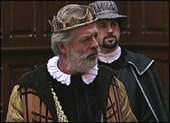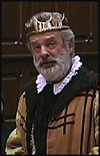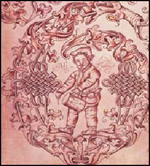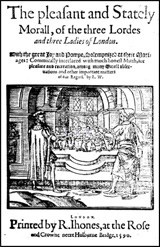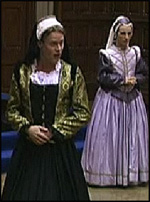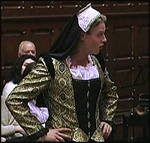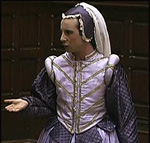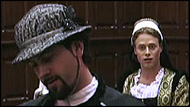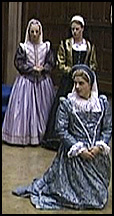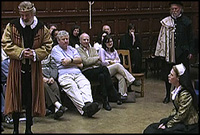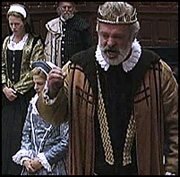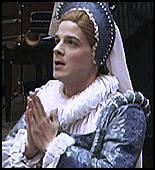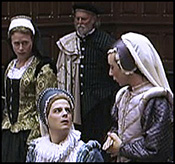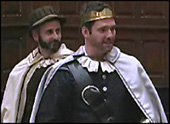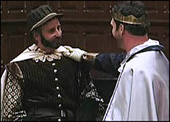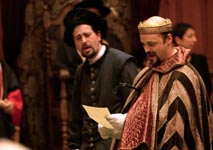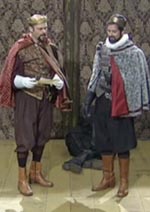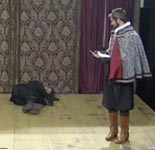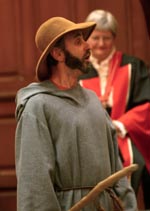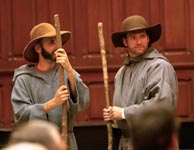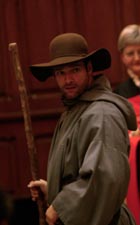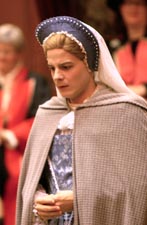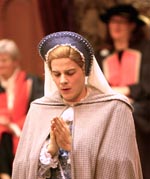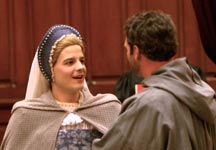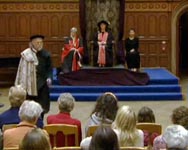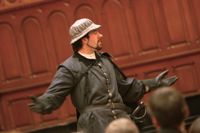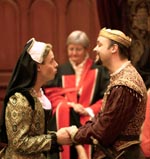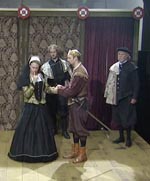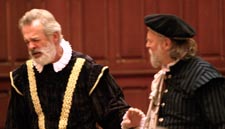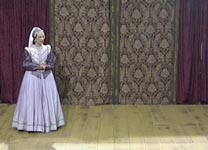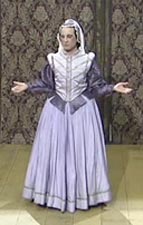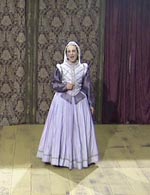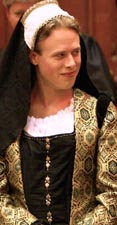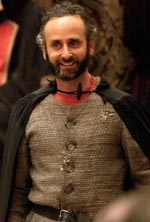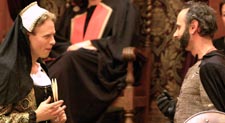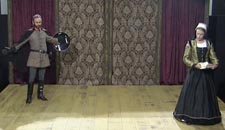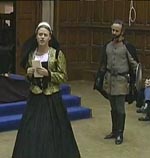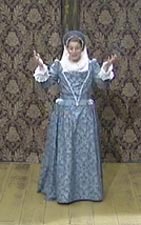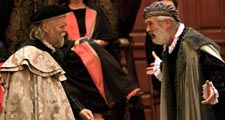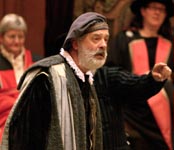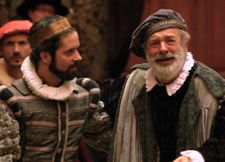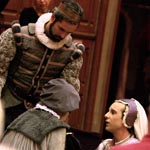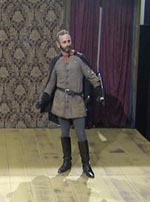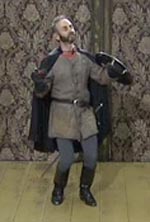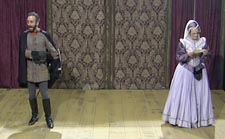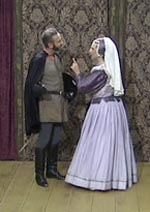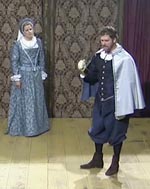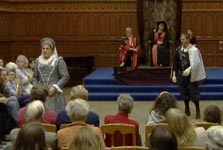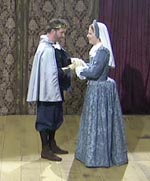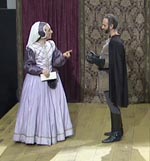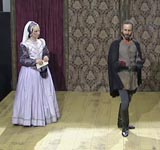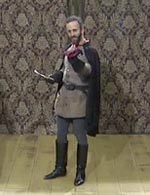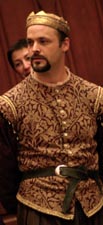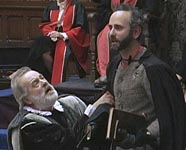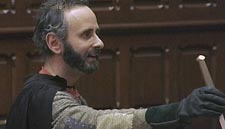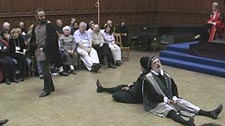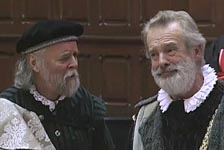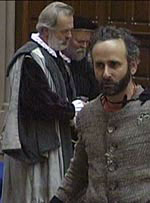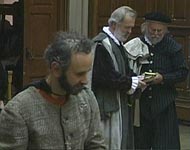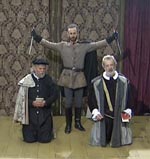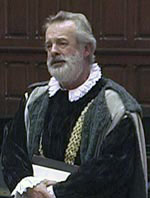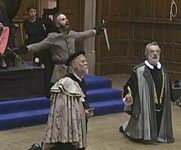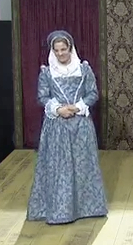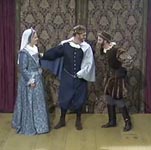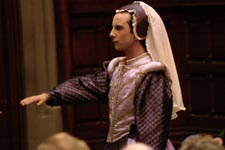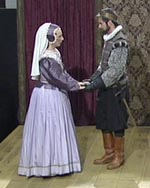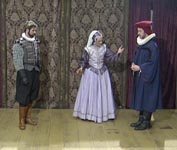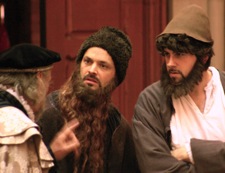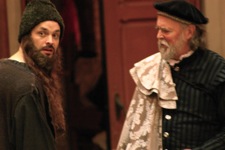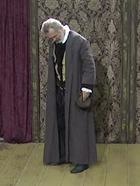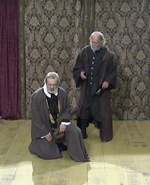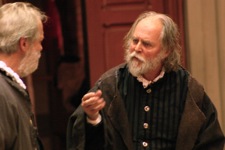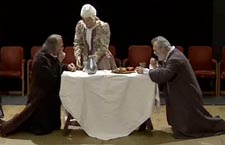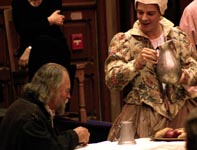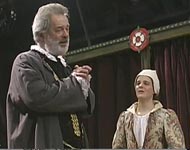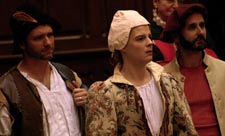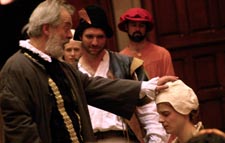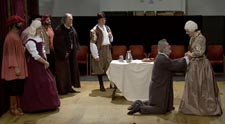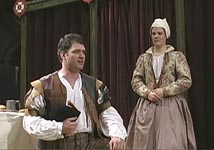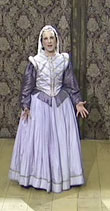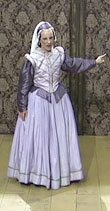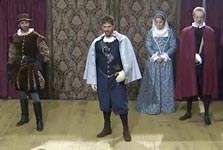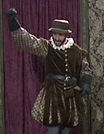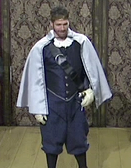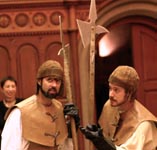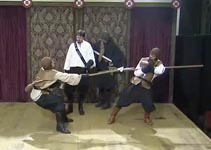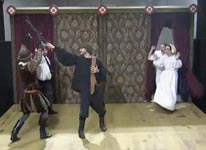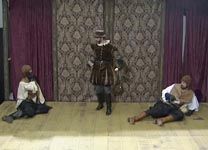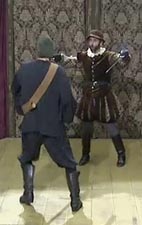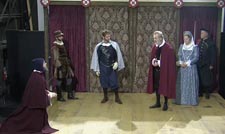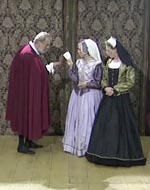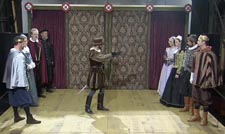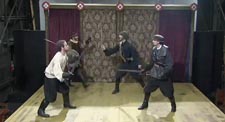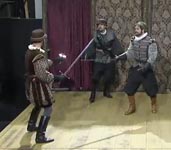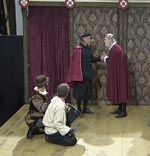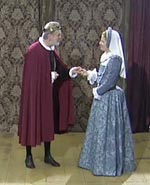- Edition: King Leir
King Leir
- Introduction
- Texts of this edition
- Contextual materials
- Facsimiles
1King Leir, Scene 1
Cast
Skalliger: David Kynaston
King Leir: Don Allison
First Lord: Phil Borg
Perillus: Peter Higginson
Performing King Leir: Psychology, Acting and Parts
2 The opening scene of the first play in the SQM company's repertoire, Scene 1 of King Leir became a testing ground for our working process. The company of actors had only just been introduced to Elizabethan rehearsal practices and our initial approach to the opening scenes of King Leir followed the conventional pattern of twenty-first century rehearsal with which they were all familiar. Don Allison (Leir) was initially bemused by the text, finding it difficult to understand and impossible to memorize. In an interview on the Performing the Queen's Men website Allison describes how his response was colored by a recent experience with Shakespeare's Lear. To him the text of the Queen's Men play lacked "poetry" and coherence: he struggled to understand it and especially to put the lines into the "emotional context" of the character he was charged with playing.
3The scene provides conflicting information about Leir's state of mind, which puzzled Allison and led to much exploratory work. The syntax in the opening speech, for example, is convoluted to the point of obfuscating the sense and proved extremely difficult to memorize as Leir skips from one thought to the next without making the connections clear (TLN 1-29). Working past Don's initial response that the speech was badly written and a pale precursor of Shakespeare, we took the position that the disruptions in the speech must be signs of Leir's grief at the loss of his wife. Later in the scene, however, Leir is suddenly eloquent and decisive (TLN 39-42) appearing to be a statesman in full control of his faculties. Having given the impression in his opening speech that he is incapable of dealing with his daughters, Leir then reveals that he has already made clear plans and is pleased that they are echoed by the nameless Nobleman (TLN 56-58). This shift struck Allison as an inconsistency that required attention. Is Leir really overwhelmed by grief when he comes to the scene with a plan for his daughters already in place? Allison experimented with the idea that Leir was an expert political manipulator and that his initial speech was in part a performance of grief and helplessness intended to elicit support for his political agenda from his courtiers. This strategy was playable but undermined Leir's affection for his wife and made his character less appealing.
4 We then pushed the scene in the opposite direction, experimenting with more extreme expressions of grief, creating a version of Leir verging on madness. In rehearsal this seemed at odds with the clear assertion and execution of his authority at other moments in the scene. Furthermore, the opening speech contains so many important plot points there was a limit on how far he could push this grief. We needed the audience to understand what he was saying. As the ramblings of a grieving man this speech makes psychological sense but as the introduction to Leir's character and a means to communicate important past events, its lack of clarity was problematic.
5 Much time was invested in this scene and gradually Allison brought the two poles of his interpretation together and performed Leir as a shrewd and capable king who was feeling increasingly unsure of himself since the death of his queen. He was pleased to find his nobles' wishes concurred with his own plans and was emboldened to think of ways to deal with his one disobedient daughter Cordella, but his emotional fragility was apparent. When Perillus challenged his plan for Cordella, Don delivered the line "I am resolved" with vehemence (TLN 77). The disastrous "sudden stratagem" (TLN 78) of the love test was understood as a product of his grief.
6The process described here has more to say about the twenty-first century acting techniques than about the play or the original company. In keeping with our training, Allison and I collected all the pieces of evidence in the text and related them to each other in order to develop a performance that felt psychologically consistent. Having done this work Allison was able to place Leir's lines within the "emotional context" he had built and perform them with conviction. This approach to acting has been developed in the relative luxury of the modern rehearsal room but the original actors did not dedicate the same time to ensemble rehearsal. From what we understand of Elizabethan rehearsal, actors worked on their parts alone and generated performances in response to the rhetoric found in their characters' speeches. Don is an experienced classical actor and he too was responding to the variety of rhetorical devices and styles employed by the playwright but even in the relatively pressured SQM rehearsal process he had more time to arrange the pieces into what felt like a complete and consistent characterization before walking on stage in front of a live audience.
7 When the original Queen's Men actors approached the same material alone and without access to the entire text, the sense of consistency and unity, necessary to give the actor the confidence to step out on stage and play a character, must have been built on other ground. Working on the SQM productions I came to the conclusion that they must have relied on the notion that each character was a type of part. In this case, Don is playing a "king" and each of his speeches is a rhetorical action performed by a king: the king grieves, the king asserts his authority, the king hatches a plot and so forth. The nature of the action is defined by the rhetoric of the part that is designed to have a particular effect on the listener. An actor knowing how to play the part of a king need only study the rhetoric of his part to understand the specific intentions of each speech. Performed in sequence the speeches tell the story of a grieving king, trying to manage his daughters alone for the first time, and making what will prove to be a disastrous decision. Taking such an approach the performance of the king need not be less complex than Allison's but the route to achieving it would be more direct.
8 Early modern actors likely did not spend time developing the particularities and idiosyncrasies of a unique character psychology and were thus able to perform a larger repertoire and prepare plays for the stage more quickly. The Queen's Men plays were not necessarily conceived in such terms and the SQM company found that removing the idea that each character should be a unique individual from the actor's work saved a lot of time and was a major factor in enabling the company to get the three plays on their feet with, what was for them, relatively little rehearsal. In the case of this scene, such an approach would have been more direct, by-passing exploration of character psychology, and would still have allowed for complexity, since the complexity is contained in the rhetoric of Leir's various speeches. Reflecting on his experience working on the SQM productions, Peter Higginson (Perillus) noted that the key factor was the intense focus on the text.
Watch video of the opening scene on the Performing the Queen's Men website. (The video footage is password protected. Click on "Cancel" in the pop-up window to obtain password.)
The Queen's Men and Shakespeare
9Shakespeare's plays, Lear, while using the same arguments, is more consistently eloquent and commanding in the opening scene. King Lear's emotional instability is made apparent from the start, but the daughters are left to observe "how full of changes [Lear's] age is" ![]() (F: TLN 314) and to suggest that "he hath ever but slenderly known himself"
(F: TLN 314) and to suggest that "he hath ever but slenderly known himself" ![]() (F: TLN 318-9). Leir's opening scene gives the majority of attention to the king's grief, the political problem of succession, and the wisdom of the proposed course of action, but Shakespeare's play shows more interest in the issue of Lear's character. In the following scene in the Queen's Men play, the sisters are driven by their jealous hatred of Cordella rather than doubts about their father's judgment and age.
(F: TLN 318-9). Leir's opening scene gives the majority of attention to the king's grief, the political problem of succession, and the wisdom of the proposed course of action, but Shakespeare's play shows more interest in the issue of Lear's character. In the following scene in the Queen's Men play, the sisters are driven by their jealous hatred of Cordella rather than doubts about their father's judgment and age.
Watch video of the opening scene on the Performing the Queen's Men website. (The video footage is password protected. Click on "Cancel" in the pop-up window to obtain password.)
Performing Skalliger: Type characters and the Twenty-First Century actor
10 David Kynaston's development of the role of Skalliger is another good example of the relative efficiency of performing stock character types rather than investing time in the psychological motivation of characters. Skalliger is established as a Machiavel character at the end of this scene and in the next scene; following Elizabethan tradition, we dressed him in black to indicate the nature of his character. David, however, wanted more detail. In this scene, he was particularly interested in the fact that Leir appears to have given him a special license to speak (TLN 34). When was he given this license? Did they have a previous meeting addressing this issue or is he personalizing the general license to give advice contained in Leir's first speech (TLN 7)? These were questions that were important to David as he worked to individuate his character. Early modern actors would have approached this character as the type of the Machiavel and built their performance from there.
Read about David's performance of Skalliger in scene 2.
Watch video of the opening scene of the play on the Performing the Queen's Men website. (The video footage is password protected. Click on "Cancel" in the pop-up window to obtain password.)
11King Leir, Scene 2
12Cast
Ragan: Derek Genova
Gonorill: Matthew Krist
Skalliger: David Kynaston
Performing Gonorill and Ragan: Characters or Vices
13My direction to the "boys" playing these women was to think of these characters as the wicked sisters in a Cinderella pantomime. I wanted them to be the Vices to Cordella's Virtue. Having worked on Robert Wilson's The Three Ladies of London in preparation for the SQM productions, I was curious about the possible connection between the women in Leir and in Wilson's play, which shows how the Vice Lady Lucre corrupts the Virtues Lady Love and Lady Conscience. Wilson became a Queen's man and his play could have been part of the company repertoire as was its sequel: The Three Lords and Three Ladies of London. The same actors may well have played the female roles in Wilson's plays and in King Leir. Would the original actors have approached their performances in the morality play and the romance differently or would they have treated the characters in similar fashion?
14 Our twenty-first century actors initially followed their own familiar process, searching the text for evidence to motivate their characters; specifically, they focused on the fact that Cordella is a favorite at court (TLN 107-108), on the accusation that she imitates their innovative fashions (TLN 101-104), and on their fear that she may take a husband first and be granted pre-eminence over them (TLN 115-120). There are solid grounds for psychological motivation here but, in my effort to emphasize historical difference, I encouraged the actors simply to enjoy the presentation of their characters' wickedness rather than perform any justification. Conceiving the characters as representations of virtues and vices pushed the company away from their modern milieu of psychological realism and encouraged them to experiment with alternative approaches to performing. In this scene, they played Gonorill and Ragan as the vices Envy and Pride.
Watch video of Scene 2 on the Performing the Queen's Men website. (The video footage is password protected. Click on "Cancel" in the pop-up window to obtain password.)
16Building on an perceived sexual innuendo on the word "nothing" in Scene 6 (TLN 490-492) the "boys" also played up their characters' sexuality in this scene. When Gonorill swore by her "virginity" (TLN 121), Krist's delivery implied that either she was no longer a virgin, or that the loss of her virginity could not come a moment too soon. Ragan responded in like fashion when imploring her sister to "Swear not so deeply" (TLN 126) giving the line an anatomical inference. The "boys'" performances conflated the characters' sexual desires with their political aggression and thus played into conservative patriarchal assumptions about the dangers of female sexuality. Such moments of overt sexuality made me most aware of the politics of representation brought into play when "boys" play women. I saw them as always performing women in quotation marks, framed by the perspective of their own gender and biased accordingly. Others on the SQM team argue that the gender of the actor became immaterial in performance. You may come to your own opinion by watching video of the "boys" in action.
Read more about performing Gonorill and Ragan
Watch video of scene 2 on the Performing the Queen's Men website. (The video footage is password protected. Click on "Cancel" in the pop-up window to obtain password.)
Queen's Men Dramaturgy: Narrative Over-Determination
17Unlike Gonoril and Regan in King Lear the Queen's Men's sisters reveal their aggressive and deceptive intentions from the start. Their target is their sister Cordella. Once their course of action is established they spend the remainder of the scene gloating over their anticipated revenge on their "proud" sister. Their clarity of purpose and the action that follows illustrates their dramaturgy, typical of the Queen's Men, which McMillin and McLean refer to as "narrative over-determination". The characters tell us exactly what they are going to do and in the next scene we see them do just that. Performing them as Vices or pantomime villainesses added to the sense of "over-determination" as Vice characters are certain to behave viciously. The sisters' openly wicked intentions raise clear expectations of the action which then unfolds with the pleasurable predictability of a fairy tale, pleasing through the resolution of conventional narrative expectations rather than unexpected twists and turns.
18Although the actors had plenty of information on which to build psychological motivation in this scene, the SQM company developed a style that was more demonstrative and pantomimic. While the interpretation lacked subtlety and complexity, the actors' relish of their characters' wickedness brought its own pleasures as may be seen in the video of the performance.
Read more about narrative over-determination
Watch video of scene 2 on the Performing the Queen's Men website. (The video footage is password protected. Click on "Cancel" in the pop-up window to obtain password.)
Performing Skalliger: Type characters and the Twenty-First Century actor
19Read about Kynaston's performance of Skalliger in the first scene.
20 David Kynaston's application to the character of Skalliger in the early stages of our production process is typical of the twenty first century rehearsal practice and also indicative of the necessarily different approach that must have been a part of the original actor's technique. Skalliger claims in this scene that Leir has confessed "in great secrecy" (TLN 134) details of the marriage plans for his daughters, plans that were not shared in the previous court scene. This evidence led Kynaston to wonder when exactly did his character speak to the king about the marriage schemes? His exit line in the previous scene (TLN 92) implies that Skalliger hurries here directly. If he had done so, reasoned Kynaston, then the secret conference with the king must have occurred prior to the opening scene of the play and, on the basis of this deductive reasoning, Kynaston decided that Skalliger enjoys a privileged relationship with the king. Kynaston also noted the inconsistency when Skalliger says "I am glad I met you here so luckily" (TLN 134) implying an accidental meeting when he left the previous scene with the express intention of finding them.
21 Kynaston built a convincing performance of the manipulative Skalliger through his careful application to textual evidence but his investigative process would have been impossible in the rehearsal conditions of early modern theatre. The Queen's Men largely rehearsed alone and with only their parts in hand. Kynaston's elaborate cross-referencing depends on easy access to the full text and repeated rehearsal of the scene. Without these options, it is likely that the original actor would have identified the character as a familiar type: the Machiavel. An actor familiar with the type and confident in its performance conventions can learn his lines and walk out on the stage to speak them with conviction with minimal rehearsal. As the SQM project progressed and less and less time was available for rehearsal the actors became increasingly reliant on this approach to characterization.
22Reliance on type characters can lead to simplification and a lack of psychological complexity but the simplicity of the approach held an honest charm and it was unquestionably efficient. In this instance, psychological complexity was not required for the performance of Skalliger, who has a short-lived and relatively straightforward function to perform in the telling of the story. The time spent on this in rehearsal was really time wasted.
Read about performing Skalliger's final appearance in the play
23Watch David Kynaston describe how he felt the extra rehearsal spent on Leir in comparison to other plays proved damaging in the end, on the Performing the Queen's Men Website.
Watch video of scene 2 on the Performing the Queen's Men website. (The video footage is password protected. Click on "Cancel" in the pop-up window to obtain password.)
24King Leir, Scene 3
Cast
King Leir: Don Allison
Perillus: Peter Higginson
Skalliger: David Kynaston
Ragan: Derek Genova
Gonorill: Matthew Krist
Cordella: Julian DeZotti
Queen's Men Dramaturgy: Moral Dichotomy (Sc. 3)
25 If we approach Shakespeare's play without any prior knowledge of the story, then we may be uncertain whether Goneril and Regan are falsifying their love at the moment when they first speak. Cordelia does not pass comment until after the elder sisters have spoken, and initially Cordelia's comments are enigmatic, she knows her "loue's/More ponderous then [her] tongue" (![]() F: TLN 83-4). Kent subsequently defends the depth of Cordelia's love and challenges the elder sisters to live up to their words but does not say they are liars (
F: TLN 83-4). Kent subsequently defends the depth of Cordelia's love and challenges the elder sisters to live up to their words but does not say they are liars (![]() F: TLN 153-164). Unlike the Queen's Men play Shakespeare does not confirm they are lying until after they speak; it remains a matter of opinion until the sisters contradict their expressions of love at the end of the scene and reveal their lack of respect for their father. King Leir,in contrast, has taken pains to establish the moral framework for the audience by having Gonorill and Ragan flaunt their wicked intentions in the previous scene.
F: TLN 153-164). Unlike the Queen's Men play Shakespeare does not confirm they are lying until after they speak; it remains a matter of opinion until the sisters contradict their expressions of love at the end of the scene and reveal their lack of respect for their father. King Leir,in contrast, has taken pains to establish the moral framework for the audience by having Gonorill and Ragan flaunt their wicked intentions in the previous scene.
26The two scenes can be distinguished by the degree to which they control the audience's interpretation of the action. The moral purpose of the Queen's Men scene is more clear-cut than Shakespeare's and owes much to the morality tradition that was still central to the theatre scene in the 1580s. Shakespeare's company also performed moral plays, and I am not suggesting any absolute break from tradition here, but the dramaturgy of his version of this scene allows for a greater freedom of interpretation. In contrast, the Queen's Men dramaturgy is comparable to Bertolt Brecht's use of title cards that describe the action of the scenes that follow - the audience is told what is going to happen and can then focus on how it happens. By previously establishing the malicious intentions of Gonorill and Ragan the audience is encouraged to adopt a particular perspective on the morality of the action. The narrative over-determination discussed in relation to the previous scene is dramaturgically central to the Queen's Men's moralizing drama.
Read more about Queen's Men Drmaturgy: Moral Dichotomy
Performing the Love Test (Sc. 3)
27 The different dramaturgy invited a different approach to performance. Maintaining their commitment to the wickedness of the sisters established in scene 2, the actors made it perfectly apparent that they were lying to their father. This performance choice met with resistance from the company since the sisters' lies were also apparent to Don Allison, the actor playing Leir. One of the principal rules of psychological realism is that if your character is lying, lie well, or else you will make your acting partner's character appear stupid and therefore undermine him or her in the eyes of the audience - blatant lying is the territory of comedy not psychological realism or tragedy. Part of our struggle with this scene involved separating the Queen's Men's play from Shakespeare's and all the cultural expectations that arise from that association. The Queen's Men Leir is not a tragedy; it is a moral romance and the dramaturgy encourages a playful approach to all aspects of the story. In this scene, emphasizing the daughters' deception pushed the scene towards comedy, exposing the folly of the protagonist, an effect that was very much in keeping with the play's morality.
28Each sister takes a moment to indirectly attack Cordella, the real target of their deception. Gonorill refers to Cordella's refusal to obey Leir in her choice of husband:
Nay, more, should you appoint me for to marry
The meanest vassal in the spacious world,
Without reply I would accomplish it. (TLN 248-250)
29Ragan also refers to her obedience in marriage and more openly challenges Cordella, saying:
Oh, that there were some other maid that durst
But make a challenge of her love with me (TLN 261-262)
30Matthew Krist (Gonorill) gave many of his lines in this scene a mock insouciance and Derek Genova (Ragan) inclined his head towards Cordella marking her as implied object of the challenge. These performance choices emphasized the difference between the intentions of their words as perceived by Leir and the actual intention understood by the audience. Our awareness of the discrepancy was pleasurable and encouraged us to enjoy the sisters' wickedness, while at the same time reminding us of the king's folly.
31 Developing the appropriate style for this scene and the play as a whole was a delicate balancing act: over-emphasizing the comedy would have undermined the emotional import of the scene, which, for all the characters, is extremely high. With rehearsal, the company found the requisite balance and became comfortable with the mixture of comic elements and high emotion that is characteristic of the Queen's Men dramaturgy. Don Allison (Leir), for example, began to add a touch of childlike naivety to his responses to the flattery (TLN 253 and TLN 273), which illuminated his moral folly by highlighting his inability to recognize his daughter's lies. The company became adept at shifting the tone of the scenes from the comic to the serious. The audience laughed at the sisters obvious lies but the laughter stopped when Allison (Leir) became consumed with fury at the line "Peace, bastard imp" (TLN 312).
Watch video of Scene 3 on the Performing the Queen's Men website. (The video footage is password protected. Click on "Cancel" in the pop-up window to obtain password.)
Queen's Men Dramaturgy: Sudden Emotion and the Medley Style (Sc. 3)
32Shakespeare teases out Lear's transition from confusion to fury with a 21 line exchange between father and Cordelia (![]() F: 93-114), but King Leir's rage is more sudden: he responds to Cordella with "What minion?" and, prompted by Gonorill and Ragan's pretended shock, he launches into a tirade against disrespectful children. The SQM company found that the plays were full of such sudden shifts of extreme emotion. In fact, each of the plays contains an important conversion scene that is constructed to make a feature of this performance technique. For actors used to psychological realism and its gradually shifting emotional states, this device was alien. Half-hearted commitment falsified these moments and the actors found that they simply had to jump into the new emotional state without reservation. The fact that the audience may have been laughing immediately before, or that their character was previously in an entirely different state, was no excuse for not committing to the sudden shift in emotion. In this instance, by the time Leir interrupts Cordella with "Peace, bastard imp" (TLN 312) - the kind of shocking epithet that Shakespeare reserved for later in his play - Don Allison (Leir) was fully committed to an overpowering and irrational fury.
F: 93-114), but King Leir's rage is more sudden: he responds to Cordella with "What minion?" and, prompted by Gonorill and Ragan's pretended shock, he launches into a tirade against disrespectful children. The SQM company found that the plays were full of such sudden shifts of extreme emotion. In fact, each of the plays contains an important conversion scene that is constructed to make a feature of this performance technique. For actors used to psychological realism and its gradually shifting emotional states, this device was alien. Half-hearted commitment falsified these moments and the actors found that they simply had to jump into the new emotional state without reservation. The fact that the audience may have been laughing immediately before, or that their character was previously in an entirely different state, was no excuse for not committing to the sudden shift in emotion. In this instance, by the time Leir interrupts Cordella with "Peace, bastard imp" (TLN 312) - the kind of shocking epithet that Shakespeare reserved for later in his play - Don Allison (Leir) was fully committed to an overpowering and irrational fury.
Watch video of Scene 3 on the Performing the Queen's Men website. (The video footage is password protected. Click on "Cancel" in the pop-up window to obtain password.)
Read more about Queen's Men medley style
Performing Cordella (Sc. 3)
33 The audience meets Cordella in person for the first time in this scene. They have heard of her resistance to her father's marriage plans, that Perillus esteems her, and that her sister's despise her for pride and arrogance, but they have yet to form their own opinion. In the SQM production, Cordella was dressed in a relatively modest satin blue dress that distinguished her from her more garishly costumed sisters. On entering she took up a position stage left, on the margins of the scene but with easy access to the audience beside her. Since the audience knows Gonorill is lying, they also know that Cordella speaks the truth when she identifies her sister's words as flattery. From his position at the side of the stage, Julian DeZotti (Cordella) was able to develop an intimate relationship with the audience.
34 I encouraged DeZotti (Cordella) to conceive of his character as a representation of feminine virtues, the moral and theatrical counterpoint to her Vice-like sisters. Julian found this direction extremely limiting and over the course of the run developed a better rounded character that in retrospect I believe was a truer reflection of the character as represented in the text. In this scene, Julian played Cordella with a quiet, modest humility, but as elsewhere, the text implied a strength of mind and assertiveness beyond the limitations of conservative patriarchal ideals. Here, Cordella resists her sisters' arguments accusing them of manufacturing their own false tributes: "The praise were great, spoke from another's mouth,/But it should seem your neighbors dwell far off" (TLN 306-7). As Julian became more comfortable with his role and developed his characters for the other plays, Cordella became increasingly assertive and admirable in her desire for self-definition.
35Read more about performing Cordella in the SQM production.
Read more about Julian's performances in the SQM productions and watch video interviews with the actor on the Performing the Queen's Men website.
Watch video of Scene 3 on the Performing the Queen's Men website. (The video footage is password protected. Click on "Cancel" in the pop-up window to obtain password.)
36King Leir, Scene 4
Cast
Mumford: Alon Nashman
Gallian King: Paul Hopkins
French Lord: Scott Maynard
Queen's Men Dramaturgy: Medley Style (Sc. 4)
Read about Queen's Men medley style in Scene 3
37In relation to the other plays performed in the original SQM productions King Leir is comparatively consistent in style, the regularity of the versification creates this illusion. Variety remains a guiding principle in the Queen's Men's dramaturgy in this play and Scene 4 steers the action away from the serious matter featured in the play up to this point. On the page, little appears to be happening, but the SQM actors gave the scene a playful quality that brought the scene to life,raising expectations of future fun while launching the storyline that would eventually bring the play to its happy conclusion.
Performing The Gallian King (Sc. 4)
38 Paul Hopkins, as the Gallian King, brought youthful charisma to the role, focusing on the king's desire for adventure and fun, and his apparent love of disguises seen here (TLN 384) and in scene 21 (TLN 1867). By focusing on the king's adventurous youth, he helped to separate the QM play from the subsequent Shakespearean associations with the King of France. Shakespeare's King of France provides the play with an example of magnanimity, he is a man willing to marry Cordelia for her virtue alone. The Gallian King does the same but from a different context - his character is derived from chivalric romance and has more akin with the wandering knights Sir Clyomon and Sir Clamydes than with the noblemen who populate Shakespeare's history plays and tragedies. Hopkins played this scene as if the business of kingship were a burdensome inconvenience to the romantic king who was impatient to leave his land, councilors, and responsibilities behind and embark on a grand quest for love.
Read more about performing the Gallian King in the SQM production.
Watch video of scene 4 on the Performing the Queen's Men website. (The video footage is password protected. Click on "Cancel" in the pop-up window to obtain password.)
Performing Mumford (Sc. 4)
39 One of the premises of the SQM productions was that the three plays could have formed part of the Queen's Men's repertoire in the 1580s and might all have been performed by the same company of actors. This premise is impossible to prove but it was a determining factor in our casting process. We adopted the principle that actors would have specialized parts and would have taken on similar roles from play to play. One of our master actors was assigned to play the lead comic roles in each play, roles we imagined might have been performed by the famous clown actor Richard Tarlton in the original productions. Current critical understanding suggested that Tarlton specialized in working class characters. In fact the term 'clown' had double meaning in his day referring to the principal comedian in a theatrical company and to real-life country rustics. We know with a degree of certainty that the role of Derrick in Famous Victories, was performed by Tarlton. Derrick is a typical example of the 'clown' character that according to legend was popularized by Tarlton; this clown is a country bumpkin newly arrived in the city.
40 The choice of clown role was less obvious in King Leir. The witty Mumford, a jovial French courtier, seems an unlikely role for an Elizabethan clown but working on the role with our own company clown, Alon Nashman, revealed telling points of connection that suggest that Mumford may indeed have been a part for Tarlton. In this scene, for example, Mumford identifies his kinship with the English noble Blunt family, who, in keeping with their name, he defines in terms of their plain-speaking (TLN 388) and the prose he adopts to suit his disguise bears marked resemblance to the language of Derrick and other 'clown' characters.
41Imagining Tarlton playing this role adds a satisfying level of irony to the character, enhancing the comedy and establishing a playful, teasing relationship between the world of the play and the world of the Elizabethan audience. Mumford's assertion, for example that the French dames are more beautiful than the English (TLN 358-361) would have been given an amusing twist if spoken by the archetypically English clown. Indeed, the very idea of the familiar English clown playing a French courtier would have amused on a meta-theatrical level with audience and actor both enjoying the atypical casting.
42 The association with Tarlton aside, conceiving this character as a role for a principal comedian is essential to understanding the dramaturgy of the play. Mumford and his king become active agents in the unwinding of the plot and enable its turn from desperation to hope and a happy resolution. Their fun-loving desire for romantic adventure and "pleasant company" (TLN 390) is central to the spirit of the play and serve as an important contrast to the sour envy and vindictiveness of Ragan and Gonorill.
Read more about performing Mumford in the SQM production.
Watch video of Scene 4 on the Performing the Queen's Men Website. (The video footage is password protected. Click on "Cancel" in the pop-up window to obtain password.)
43King Leir, Scene 5
Cast
Cornwall: Jason Gray
Cornwall's Servant: David Kynaston
Cambria: Scott Clarkson
Cambria's Servant: Phil Borg
Queen's Men Dramaturgy: Medley Style (Sc. 5)
44Read about the Queen's Men medley style in Scene 4
This key scene embodies the dramaturgy of the play as a whole. Cambria and Cornwall both play their parts in the shocking treatment of King Leir, but here they are introduced in a different mode. They each appear on stage accompanied by an exhausted and begrudging servant. They also both have riding crops and letters, and express their eagerness to reach their loves. Initially they don't notice each other and then they "start to see each other" (TLN 421) . The repetition and mirroring in addition to what is apparently a classic double-take are techniques of comic dramaturgy and only by embracing the implications of these techniques could we unlock the spirit of the scene and the characters at this point of the play. The rehearsal process, once again, involved breaking down our neoclassical division of the serious and the comic, and separating our work from assumptions arising from our knowledge of Shakespeare's tragedy.
45 The comic tone of the scene is confirmed by the central double-entendre on the words "whole" and "hole" (TLN 453-457). The joke constructs the characters as comedic lovers and reveals that sexual desire is as much their motivating force as it is for Gonorill and Ragan, a fact emphasized during the exchange between the sisters in the following scene, which quibbles comically on "nothing" (TLN 490-493).
Read more about Queen's Men medley style
Performing Cornwall and Cambria (Sc. 5)
46 Like the King of Gallia, Cambria and Cornwall enter the action as quasi-chivalric knights, here riding desperately to meet the objects of their desires. They are products of romance, not tragedy or history. The SQM actors gave their characters a level of naivety that allowed them to live through the surprises and coincidences of the scene without commenting ironically on them. The discovery of their shared purpose and the fact that they would soon be "brothers" (TLN 445) emerged with a sense of joyful wonder. The audience could thus laugh warmly at them rather than sneer with detached ridicule. The comic interpretation of their characters in this scene proved problematic for the SQM actors when working on the more serious side of their characters later in the play.
Read more about performing Cornwall and Cambria
The Comic Servants
47 The comic servants that accompany the knights are featured only in this scene. By playing up the servants' exhaustion we were able to establish a comic tone right from the outset, priming the audience for a light-hearted reception of the two kings. The servants entered behind their sprightly, eager princes and threw themselves in a heap on the floor, addressing themselves directly to the audience. Upon their masters' exits the two servants lumbered off after them reluctantly, maintaining audience interest until the stage was finally cleared for the opening of the next scene.
Watch video of Scene 5 on the Performing the Queen's Men website. (The video footage is password protected. Click on "Cancel" in the pop-up window to obtain password.)
48King Leir, Scene 6
Cast
King Leir: Don Allison
Gonorill: Matthew Krist
Ragan: Derek Genova
Cornwall: Jason Gray
Cambria: Scott Clarkson
Lord: Phil Borg
Perillus: Peter Higginson
Queen's Men Dramaturgy: Narrative Over-Determination (Sc. 6)
49Read about narrative over-determination in Scene 2
As a director, this scene always seemed redundant to me. McMillin and MacLean identified the tendency of the Queen's Men dramatists to show a thing and report it, a characteristic of the dramaturgy that they described as "narrative over-determination." Nothing surprising happens in this scene. The events are the logical consequence of the earlier scenes and could more economically have been recounted third hand as in fact Cordella does in the following scene (TLN 599-602). So what was the purpose of this dramaturgical technique?
50The scene opens with the sisters clarifying the root cause of their hatred of Cordella, adding vanity to their list of vices. They inform us of Cordella's plight but this is information we will discover for ourselves in the next scene anyway. Leir enters defending his decision to disinherit Cordella and abdicate his throne in favor of Cambria and Cornwall, telling us that he expects their arrival "within this two days" (TLN 517), upon which words the duo expeditiously appear. Leir's next line: "But in good time they are arrived already" (TLN 518 ) always got a big laugh in performance. I always felt that the audience was laughing at the clumsiness of the storytelling at this point. I read the compression of time as a sign that the company was aware of the scene's narrative redundancy. I feel that a story editor today would suggest removing this scene, relying instead on Cordella's account of its events in the following scene to advance the story.
51My interpretation of the scene in performance was clearly colored by my own artistic assumptions and training that told me that any scene should provide some significant turn of events that advances the course of the action. I believe there is a degree of validity to my argument and other early modern plays find more concise ways to advance their stories but it is also important to acknowledge that the Queen's Men's dramaturgy has its own charm. It proceeds at a more leisurely pace and often the pleasure of localized humorous events outweighs concerns over the significance of each moment in relation to the whole. The fact that Leir makes reference to time in two the lines adjacent to the kings' entrance implies the comic effect was deliberate. It also builds on the sense of the lovers' haste established in the previous scene and the punning on the word "nothing" (TLN 491) mirrors Cambria's confusion over the words "whole" and "hole" in the previous scene (TLN 454) establishing sexual desire rather than romantic affection as the key compatibility between the sisters and the two kings - a contrast with the expressions of love between Cordella and Gallia in the following scene (TLN 634-722). In the SQM performance, Cambria and Cornwall dashed onto the stage, breathless, with a swirl of their capes to enhance the comic effect and the lusty relationships between the kings and the two wicked sisters were established in a delightful and distracting visual display. The basic narrative development - that they get married - is thus cemented in the imaginations of the audience. It was not economical in terms of time but it was more engaging and fun than the account of the same events given by Cordella in the subsequent scene.
Read more about narrative over-detmerination
Watch video of Scene 6 on the Performing the Queen's Men website (The video footage is password protected. Click on "Cancel" in the pop-up window to obtain password.)
52King Leir, Scene 7
Cast
Cordella: Julian DeZotti
Gallia: Paul Hopkins
Mumford: Alon Nashman
In contrast to the buffoonery scene 6, scene 7 was one of the most delightfully romantic scenes in the SQM performances. The focus returns to Gallia and Mumford, here disguised as pilgrims, on the shores of Britain.
Performing Mumford the Clown (Sc. 7)
53Read about performing Mumford in Scene 4
Mumford's clownish qualities are in full evidence here. The courtly formality of his opening exchange with the king is gone and he speaks in familiar, colloquial verse and prose. The scene begins with an extended gag in which Mumford fails to maintain their disguised identities by repeatedly referring to his master as "My lord" (TLN 585-589). He demands a new name to help cement their identities, rejecting the king's romantic pretentions for the plain English "Will" and "Jack."
54 The character's love of women was clear in his first scene and here he falls for Cordella as soon as he sees her. He comments comically on her commitment to a life of labor as a seamstress, giving his sexual desire expression until he is pulled out of his lustful reverie by her commitment to a "maiden's life." The exchange appears designed for performance by a principal comedian.
Read more about performing Mumford the Clown
Watch video of Scene 7 on the Performing the Queen's Men website. (The video footage is password protected. Click on "Cancel" in the pop-up window to obtain password.)
Queen's Men Dramaturgy: Medley Style (Sc. 7)
55Read about the Queen's Men medley style in Scene 5
Both of these exchanges craft the comic dialogue cleverly and were very funny in the hands of our actors, but the real charm of the scene came from its juxtaposition with Cordella's heartfelt commitment to deal with her misfortune steadfastly. Without Mumford's interjections, Cordella's struggles might have bordered on the tragic. With them we could sympathize with her plight without great fear. The scene operated in a delightful space between emotional sympathy and laughter, continually shifting us between emotional identification with the lovers and laughter at Mumford's jokes. The two responses blend into each other as we enjoy the sudden courtship while appreciating the irony of its expeditious development. Mumford's rhyme, "I like the wooing that's not long a-doing" (TLN 738), expresses a sentiment that the audience shared, and always got a big laugh. The actors playing Gallia and Cordella learned to pitch their performances in such a way to allow laughter without undermining the sincerity of their emotions. They did not allow ironic detachment to overwhelm their speedy courtship but by enjoying its suddenness themselves they allowed the audience to laugh along with their rapidly developing affections. One of the overriding principals of the SQM productions was that we would not encourage the audience to laugh at the plays themselves. This scene was an excellent example of the careful tightrope the actors walked to avoid such laughter.
56 The medley style creates a playful atmosphere within which the company explores an important social issue. The king, disguised as a poor pilgrim, falls in love with the princess brought to penury. Stripped of status by design or by misfortune, their love grows from mutual affection rather than social compatibility. The scene advocates for the importance of mutual affection in marriage - an idea that challenged the practice of arranged and politically expedient marriages common amongst the nobility. The scene develops the theme introduced at the outset of the play as Cordella freely chooses her own husband without her father's permission, a fact that challenges patriarchal authority. It was important to make the actors aware of the cultural barriers to such marriages and foster an appreciation that Cordella's willingness to love below her station was remarkable to Gallia.
While Gallia is impressed by Cordella's commitment to love regardless of wealth and social status, the audience is always aware that she is in fact in love with a king. The multiple ironies surrounding their identities situate the action in the never-land of romance where characters make choices free from the contingencies of the everyday world. Their conversation tests their resolve and commitment to their love, but we are aware throughout that the pilgrim is in fact a king and the seamstress a princess. The scene makes its point without forcing it, charming us with romantic possibilities rather than confronting its audience with the need for social change.
Read more about Queen's Men medley style
Watch video of Scene 7 on the Performing the Queen's Men website. (The video footage is password protected. Click on "Cancel" in the pop-up window to obtain password.)
Performing Cordella (Sc. 7)
57Read about performing Cordella in Scene 3
Cordella's opening speech was particularly challenging for Julian. She begins by bemoaning her fate that contrasts so starkly with the fortune of her sisters. She blames both the "fickle queen of chance" (TLN 603) and her "father" (TLN 607) but finishes by questioning her own complaint and embracing her fate as the result of God's divine providence. This final turn proved challenging. The idea of divine providence was alien to Julian but I pushed the interpretation as central to the concept of the play. In contrast to Shakespeare's play, the narrative of King Leir is driven by God's providential justice. The play's emphasis on divine providence is a sign of its adherence to contemporary protestant dogma and to the company's ideological mission. Julian saw Cordella as far more active and determined in her commitment to make her living as a seamstress; I wanted him to play it as a submission to God's will rather than as an assertion of her own or as a sign of self-determination.
58 Our negotiations with this section of the text in rehearsal and performance were informed by our own cultural attitudes and by those attitudes contained in the script. I resisted emphasis on Cordella's courage and self-reliance as it felt too contemporary. The text implies a high degree of humility and I feared Julian's choice might emphasize individual self-determination to a degree not suggested by the text. Cordella's attitude is far removed from that expressed by Scarlett O'Hara in her comparable struggle on her heath in Gone with the Wind, to choose a more contemporary example. But Julian's resistance to the passivity was also well-founded. Cordella is submitting to God's will, but she is also recognizing that God helps those who help themselves. She refuses to be the victim here and has plans for her future - an idea that was not alien to mainstream protestant theology.
59 Julian was more comfortable developing his relationship with the Gallian King than with God, and his work on this aspect of his character revealed a strength and proactive quality beyond my conception of Cordella as a conservative, patriarchal ideal of woman. This scene supports his interpretation as she first shows a steadfast commitment to a life of labor and then proves bold enough to declare her love to the poor pilgrim, saying: "Cease for thy king, seek for thyself to woo" (TLN 691). Cordella has finally chosen her husband and her commitment to romantic love enables her to choose someone she believes is far below the social status she was born to.
Read more about performing Cordella.
Watch video of Scene 7 on the Performing the Queen's Men website. (The video footage is password protected. Click on "Cancel" in the pop-up window to obtain password.)
60King Leir, Scene 8
Cast
Perillus: Peter Higginson
Queen's Men Dramaturgy: Narrative Over-Determination (Sc. 8)
61Read about narrative over-detmermination in Scene 6.
The company felt that this scene, like scene 6, was largely redundant in performance. Perillus reports events that we have already seen on stage and then informs us of Leir's mistreatment at the hands of his daughters, something we are about to hear about in the next scene and witness in Scene 11. The actors asked if it could be cut but we held to our policy of performing the plays in their entirety.
62In performance the scene did little but make me wonder why it was there. Did the company lack faith in the power of their own story, thinking that the audience would have forgotten about Leir's actions by this point? Did they want to highlight Perillus, a character who will be a key motivator in the play's resolution? Is the play's "narrative over-determination" a dramaturgical technique devised to deal with an audience that was not paying attention?
63It is easy to exaggerate the idea of an unruly Elizabethan audience. Assessment of the eye-witness accounts of audiences refusing to sit or stand silently in their place must be balanced by the fact that the theatre of the period was largely aural and depended on an audience that would listen to the words the actors were speaking. The argument that the provincial audiences visited by the touring Queen's Men would have been all the more unruly smacks of snobbery. That said, what other rationale accounts for the repetitious quality of some of this play?
64The use of short monologue scenes like this one is a technique repeated throughout the play. They punctuate the action on a relatively regular basis, each bringing a different character into focus immediately before they play a key role in the development of the story. Creating plays with many characters was one of the company's innovations, breaking with the morality tradition that typically focused exclusively on the spiritual journey of one central character. Regular expository monologues may have been designed to maintain a story involving such a large number of active characters. Some of these scenes were more telling in performance than others: Ragan's monologue (Scene 25), for example, deepens the play's engagement with themes of gender and power. Repetition is an important rhetorical strategy of the period and the Queen's Men are not alone including such devices, but scenes, like this one, that only repeat information already received or about to be communicated through other means, seemed to elongate our contemporary performance without enhancing it.
Read more about narrative over-detmermination in the play
Watch video of Scene 8 on the Performing the Queen's Men website. (The video footage is password protected. Click on "Cancel" in the pop-up window to obtain password.)
65King Leir, Scene 9
Cast
Gonorill: Matthew Krist
Skalliger: David Kynaston
The Queen's Men Dramaturgy: Moral Dichotomy (Sc. 9)
66Read about Queen's Men moral dichotomy in Scene 3.
The events of Leir 8 and 9 are captured in Shakespeare's Scene 3; by comparing how these plays treat the material, we can recognize the differences in dramaturgy. Lear 1.3 begins with Goneril asking for confirmation from her steward that Lear has struck one of her "Gentlemen" ( ![]() F: 507) . Her complaint is short and to the point and situated within the business of running a household. She leaves having given her steward instructions to slight the king, an instruction that motivates the action of the next scene. In the Queen's Men scene Gonorill asks for advice from Skalliger. Skalliger tells her to "abridge" (TLN 801) the king's "allowance" (TLN 799) in "half" (TLN 801) at which she promptly informs him she has done so already but will half her father's allowance again on Skalliger's advice. Delighted to find Skalliger conformable to her own inclination, she exits. Skalliger, left on stage, calls her a "viperous woman" ( TLN 811) and anticipates heaven's revenge on her and on himself before exiting, never to be seen again.
F: 507) . Her complaint is short and to the point and situated within the business of running a household. She leaves having given her steward instructions to slight the king, an instruction that motivates the action of the next scene. In the Queen's Men scene Gonorill asks for advice from Skalliger. Skalliger tells her to "abridge" (TLN 801) the king's "allowance" (TLN 799) in "half" (TLN 801) at which she promptly informs him she has done so already but will half her father's allowance again on Skalliger's advice. Delighted to find Skalliger conformable to her own inclination, she exits. Skalliger, left on stage, calls her a "viperous woman" ( TLN 811) and anticipates heaven's revenge on her and on himself before exiting, never to be seen again.
67 Shakespeare's scene is a tightly wound 23 lines compared to 43 in Leir. If we were to judge the scenes in terms of dramaturgical efficiency and unity of action then Shakespeare would win hands down, but what does the Queen's Men play do that Shakespeare does not? In performance, Matthew Krist played Gonorill's initial speech with a brazen outrage, unleashing a vicious attack on her father and then seductively inviting Skalliger to find a solution. She then turned the tables at the end to reveal she has already taken action independent of his advice. The turn surprised Skalliger as much as the audience and prompted his commentary on her wickedness and his regret that he has to live by flattery (TLN 816). Conceived in this way, the scene becomes an opportunity for the actor playing Gonorill to demonstrate the vicious nature of the character and for the company to pass moral commentary on the corrupt world through the mouth of Skalliger. The key difference between the Queen's Men play and Shakespeare's is the lack of evidence to support Gonorill's opinion of her father's behavior. In Lear Kent does trip Goneril's servant giving a degree of justification to her actions. Leir has done nothing to provoke his daughters and his mistreatment arises from their viciousness alone. The mode of the scene is moral demonstration and once more the play reveals its indebtedness to the morality play tradition that was still a prominent feature of the Queen's Men theatrical milieu. Working with the Queen's Men plays means having to embrace the idea that the scenes can be episodic and their purpose local. The plays have a clear moral function and fulfill the company mission, establishing plays as moral entertainments, not (as some puritans argued) corrupters of souls. When working with this material today it became apparent that searching for psychological motivation was often less productive than embracing the broad, ethical attitudes represented in the characters and playing them to the full.
Read more about Queen's Men moral dichotomy.
Watch video of Scene 9 on the Performing the Queen's Men website. (The video footage is password protected. Click on "Cancel" in the pop-up window to obtain password.)
Performing Skalliger: Type Characters and the Twentieth Century Actor (Sc. 9)
68 Read about performing Skalliger in Scene 2
Skalliger reappears in this scene only to disappear from the play at its end. Before he exits he reveals his distaste for his queen and for his own complicity in her mistreatment of her father (TLN 811-816). For the actor playing the role, this parting comment gave his character depth and moral complexity that are nevertheless abandoned with Skalliger's disappearance. The play uses him to drive the intrigue at a few key moments and then simply removes him from the plot without explanation. As described above, the purpose of his parting comments was likely not connected to the development of character but to the presentation of moral argument.
69From the point of view of modern playwriting technique, Skalliger's disappearance is a problematic loose end and it remained odd to me throughout the performances. The SQM audience, however, did not seem to care. They were willing to accept a form of storytelling that was not overly concerned with tidiness and unity.
Watch video of Scene 9 on the Performing the Queen's Men website. (The video footage is password protected. Click on "Cancel" in the pop-up window to obtain password.)
70King Leir, Scene 10
Cast
King Leir: Don Allison
Gonorill: Matthew Krist
Cornwall: Jason Gray
English Lord: Phil Borg
Perillus: Peter Higginson
Performing King Leir (Sc. 10)
71Read about performing King leir in Scene 1
One of the most substantial differences between this play and Shakespeare's is the representation of the king. The kings are both accused of pride, vanity, and lack of self-knowledge; his daughters complain that he criticizes and asserts his authority even after abdication. In Shakespeare's play we see that there is some substance to his daughters' accusations (even the knowing fool agrees), but in King Leir there is no support for their mistreatment of their father. Leir is a good old man who makes a terrible error of judgment, rewarding the sisters' flattery instead of Cordella's modest honesty.
72In this scene, Leir does nothing to warrant his daughter's aggression. His comment about her "breeding young bones" (TLN 844), although taken as an insult by Gonorill, was read in performance as a hopeful surmise that pregnancy might be the cause of his mistreatment. That is, Leir intended to reassure Cornwall as well as make sense of the surprising reversal of affection he experiences at the hands of his daughter.
73Leir eventually realizes his mistake and the play takes him through a process of recognition, repentance and suffering, comparable to what we see in King Lear. The focus, however, does not fall on Leir's character development or the cultural complexities of kingship; instead, the play presents us with a spectacle of Christian suffering and an example of endurance and faith in God's providential justice. Rather than investigating the psychological complexity of the king as an individual, the role challenges a contemporary actor to empathically connect with the ideas of faith and despair. These ideas that were alien to our largely secular actors and it was necessary to highlight their importance during the rehearsal process. The dialogue between King Leir and Perillus, here and in the later scenes depends for its affect on the gravity with which early modern Christians viewed the sin of despair.
Read more about performing King Leir
Watch video of Scene 10 on the Performing the Queen's Men website. (The video footage is password protected. Click on "Cancel" in the pop-up window to obtain password.)
Performing Cornwall (Sc. 10)
74Read about performing Cornwall in Scene 5
Jason Gray (Cornwall) found his character's sudden exit from this scene difficult to motivate (TLN 850). Looking at the issue from the point of view of psychological realism: why would a character so keen to console Leir at the outset (TLN 819-810) suddenly abandon him to the anger of his daughter? Is he afraid of Gonorill? Does he have an extremely low tolerance for domestic conflict? Does he feel that it is not his place to interfere in the relationship once the depth of the conflict is clear? Jason considered all of these options but I don't believe he ever found a solution to the problem that fully satisfied him. As rehearsal progressed Jason increased the level of naivety that he brought to bear on his first scenes and used this device to build motivation for his exit here. The result was a kindly and charming king and husband who became befuddled by his wife's behavior and was unwilling to take sides; having put his foot in his mouth with his comment about a "woman's words" (TLN 843), he decides the wiser move is to absent himself from the family argument. Jason's approach to his character has much in common with Shakespeare's initial treatment of the kindly and somewhat ineffective Albany.
75His choices worked well enough for this scene but Cornwall later becomes very concerned about Leir's welfare (TLN 945-951) and retrospectively it remained strange that he should just abandon him at this point. Dramaturgically, however, his exit is convenient as it allows Gonorill to throw Leir out without her husband's knowledge. The important consequence of this is that it makes Cornwall appear to be the dupe of his dominant wife, an idea that is picked up in Ragan's subsequent soliloquy in (Scene 25). From the point of view of conservative patriarchal ideology, this inversion of authority suggests a further sign of the disorder brought about when fathers abdicate their authority to daughters.
Read more about performing Cornwall
Performing Gonorill (Sc. 10)
76Read about performing Gonorill in scene 2
In contrast to the portrayal of Leir as an innocent in this scene, Gonorill is indisputably vicious. Her cruelty has no justification aside from her selfish desires that have been made openly apparent from her first appearance on stage. The scene presents the actor with another opportunity to revel in the character's manipulative wickedness and Matthew Krist continued to enjoy doing just that, beginning with a performance of the wronged and loving wife that carried just enough irony to amuse the audience even while fooling Cornwall (TLN 832-840), and then moving to a sarcastic moral outrage when she takes mock offence at the implication that she might have been pregnant before she was married (TLN 846-849).
Read more about performing Gonorill
Watch video of Scene 10 on the Performing the Queen's Men website. (The video footage is password protected. Click on "Cancel" in the pop-up window to obtain password.)
Queen's Men Dramaturgy: Moral Dichotomy (Sc. 10)
77Read about Queen's Men moral dichotomy in Scene 9
As critics point out, Lear's culpability is an open question in Shakespeare's play; in Leir, this ambiguity vanishes as the play defines Gonorill and Ragan as evil from the start and depicts Leir as a good man suffering as a consequence of one error of judgment rather than because of a flaw in his character, a lack of self-knowledge, or his insensitivity to those over whom he ruled - all of which are implied in Shakespeare's play. In King Leir, good is set more clearly against evil. God's providential justice will lead the good king through suffering and penitence to reconciliation and a happy resolution. Such providential orderliness is a stark contrast to Shakespeare's Lear. Even at moments of high conflict, as in this scene, the quality of pantomime in the villainy invites a strikingly different response from the audience - its transparency makes it more playful and less perplexing than the same wickedness in Shakespeare's play. In performance we could have encouraged a less light-hearted approach coupling the playfulness of the sisters with a fearful awareness of the influence of evil in the world. The comedy of the devils in the morality tradition is often both funny and spiritually frightening in this way and by not considering the spiritual dimension here we may have diluted the emotional impact of the sister's wickedness. The moral dichotomy would remain clear-cut but the affect could have been more complex.
Read more about Queen's Men moral dichotomy
Watch video of Scene 10 on the Performing the Queen's Men website. (The video footage is password protected. Click on "Cancel" in the pop-up window to obtain password.)
Queen's Men Dramaturgy: Rhetoric of Emotion (Sc. 10)
78Leir's treatment by Gonorill causes him to long for death and to weep. Perillus then steps forward to rescue his master from despair, kindling his hope that Ragan will treat Leir more kindly. The pattern of this scene is repeated later in the play and much time is invested in these exchanges. In terms of action, it first appeared relatively static to us: Leir despairs, Perillus persuades him to hope again. But in the world of the play this action is highly significant and for this section we did draw on the spiritual context of the conflict to give the action a greater sense of urgency, stressing the dire consequences of despair for Christian believers.
79The exchange is constructed using patterns of rhetoric that give a formal beauty to an emotional development that will subsequently shape the play's action. Perillus' persuasions are drawn out across a series of rhetorical figures in which the friend picks up on the complaints of his king and cleverly turns them into justifications for his own loyalty. Leir then turns the tables on his friend by arguing that rationality has no authority in a world where daughters can undermine "sacred law" (TLN 898) and "condemn, despise" and "abhor" their fathers (TLN 904). At this point, Perillus resorts to the eloquence of his own tears that weep in sympathy with Leir and prove his own "love" for his master (TLN 906).
80 The rhetorical patterning requires the actor to allow the character to be conscious of his manipulation of language. Rather than attempting to give the verse a natural quality as if imitating everyday speech, the actor must accept that the characters are consciously and deliberately engaging in a rhetorical game as they each pick up on the rhetorical figures and arguments of the other. The beauty and charm of the technique come from the combination of rhetorical word-game and high emotional stakes. Since the technique occurs twice more in the play (TLN 1094-1117) and (TLN 2038-2081), the appeal of this dramaturgy for a contemporary audience was obviously something that the Queen's Men felt they could rely upon. Don Allison and Peter Higginson, the actors that performed this scene, are both adept verse-speakers and were able to capture the appeal of the technique for our twenty first century audience.
Read more about the rhetoric of emotion in the SQM production
Watch video of Scene 10 on the Performing the Queen's Men website. (The video footage is password protected. Click on "Cancel" in the pop-up window to obtain password.)
81King Leir, Scene 11
Cast
Ragan: Derek Genova
Queen's Men Dramaturgy: Narrative Over-Determination (Sc.11)
82Read about narrative over-determination in Scene 10
Here, another soliloquy is inserted between scenes to set up subsequent action and provides another example of narrative over-determination. Ragan's joyful mood provides an instant contrast with the proceeding scene and her determination to send her father "packing" (TLN 941) removes any element of surprise surrounding the action to come. The expectations raised are clear. Leir will arrive and be as sorely abused by Ragan as he was by Gonorill. The dramaturgy generates anticipatory fear for anyone empathizing with Leir but also makes the development of the plot predictable. In performance, the archness of our wicked sisters suggested another possible function of this dramaturgical strategy. The affect has something in common with the "He's Behind You!" gag from British pantomime. The lead actor stands on stage and asks the audience to let him know if they see the villain, who promptly appears upstage and creeps towards the hero. The mistreatment that is heading towards Leir is made so obvious that it took on qualities of this routine. Once again, the play proved far more playful than we first imagined, coming to it as we did, under the shadow of King Lear. The company developed a naive clown-like quality for the performances that served this aspect of the plays very well and became one of the defining aspects of the SQM style.
Read more about narrative over-determination
Watch video of Scene 11 on the Performing the Queen's Men website. (The video footage is password protected. Click on "Cancel" in the pop-up window to obtain password.)
The Qeen's Men and Shakespeare (Sc. 11)
83Read about the Queen's Men and Shakespeare in Scene 1
Shakespeare's manipulation of expectation in King Lear is more complex and may well have been playing on residual expectations in his audience arising from memory of the Queen's Men play. Shakespeare's audience is led to believe that Cordelia was coming to save her father only to be surprised when the French army loses and Cordelia is imprisoned. The martial Edgar then becomes the hope of salvation and carries the hope of divine justice on his sword but although he defeats Edmund in single combat, his effort comes to late to save Cordelia and the King. The Queen's Men's dramaturgy confirms the power of God's Providence; Shakespeare raises comparable expectations only to disappoint the very expectations he raises. The Queen's Men's play falls steadily in line with protestant ideology thus serving the political mandate of the company as conceived by Walsingham and Leicester, according to McMillin and MacLean. With the playful quality developed by the company the happy outcome was never really in doubt in performance.
Performing Ragan (Sc. 11)
84Read about performing Ragan in Scene 2
The play goes out of its way to show that both Ragan and Gonorill dominate their husbands. The SQM actors playing Ragan and Gonorill took great relish in manipulating Cornwall and Cambria. In a modern context their empowerment was not controversial or threatening. The audience enjoyed the characters and laughed at their obvious manipulation of their husbands. Watching the performances, however, and imagining the same scenes performed in their original context, I wondered how they would have been received. From a traditional, patriarchal perspective, the queens' behavior would have been defined as an inversion of "natural" order (http://internetshakespeare.uvic.ca/Library/SLT/ideas/order/sexes.html). Transgressive women were perennially popular figures in early drama - the Noah's wife characters from Flood plays of York, Wakefield and Chester are pertinent examples. The audience likely still laughed, but would part of that laughter have been scorn directed at the ignorant husbands? Would the laughter have been enhanced by the element of transgression in their behavior?
85The company's performances of gender clearly engaged with the complex, contemporary discourse generated in part by the presence of their patron, the female ruler of the country. While in matters of religion and political authority their position is crystal clear, in matters of gender their message is more difficult to define. The good Cordella is presented in juxtaposition to her wicked sisters, but she too resists male authority and her refusal to obey Leir in matters of marriage is depicted in a positive light. I suspect that the humor surrounding the wicked queens that proved still to be enjoyable today might have had a more contentious edge in the original performances.
Read more about performing Ragan
Visit the Performing the Queen's Men website to explore the issue of gender in the SQM performances.
Watch video of Scene 11 on the Performing the Queen's Men website. (The video footage is password protected. Click on "Cancel" in the pop-up window to obtain password.)
86King Leir, Scene 12
Cast
Gonorill: Matthew Krist
Messenger: Alon Nashman
Cornwall: Jason Gray
Lord: Scott Maynard
Performing Gonorill (Sc. 12)
87Read about performing Gonorill in Scene 10
Matthew Krist (Gonorill) once more made his manipulation of the husband openly apparent to the audience. In this scene, however, the series of tactics he employs do not work. He played the aggrieved little girl ("Alas, my lord..." TLN 952-4), attempted calm reassurance ("I know he is but stol'n..." TLN 956-61), and finally flirted with her husband ("Therefore, my lord, be frolic..." TLN 962-3) but to no avail. His character is forced to take the extreme measure of intercepting the Messenger. The archness of Krist's performance gave the character the quality of a pantomime villainess.
Matthew built on his interpretation of his character's sexuality in this scene, using his sexual charms to persuade the Messenger to risk his life in his character's service. The scene between him and Alon Nashman (Messenger) was highly charged and Gonorill left the stage fanning herself with her letter.
Read more about performing Gonorill.
Watch video of Scene 12 on the Performing the Queen's Men website. (The video footage is password protected. Click on "Cancel" in the pop-up window to obtain password.)
Performing Cornwall (Sc. 12)
88Read about performing Cornwall in Scene 10
In this scene, Cornwall is more in control of his court and his wife's efforts do not deflect him from his concern that Leir has been mistreated. He does, however, fail to see through his wife's manipulative tactics or connect Leir's sudden departure with the way he was treated by his daughter in Scene 10.. As the play progressed Jason Gray (Cornwall) found it necessary to give his character more substance and move away from the naivety that had worked so well in the earlier scenes.
Read more about performing Cornwall.
Performing the Messenger (Sc. 12)
89The text shifts the character's name from Messenger to Murderer once he is engaged by Ragan to kill her father. When first casting the play it seemed unlikely that a character entitled "Murderer" should be a comic character but on close reading, so many of the lines are intended to elicit laughter that a comic interpretation seemed most appropriate. As I was finalizing the casting I noticed that the character of Mumford -- assigned to the company clown -- disappears from the stage when the Messenger/Murderer appears, making it possible to double the two roles, and assign them to Alon Nashman, SQM's chief comic performer.
90This casting created an opportunity for a virtuoso comic performance and increased my suspicion that these roles might have been devised for Richard Tarlton. In this scene, the Messenger refers to himself as a "handsome man" (TLN 1000), which is possibly an ironic reference to Tarlton's famously funny face - the gag is repeated by Derrick in Famous Victories, a role we can be almost sure was played by Tarlton. The Messenger speaks in colloquial prose comparable to Derrick's and his reference to the oyster-wives of Billingsgate (TLN 1023) and his parish neighbours implies he is a London local. Tarlton was a familiar figure in London and his clowning often played off his identity outside of the theatre, blurring the distinction between man and clown.
91My obsession with Tarlton and this role created problems in the rehearsal room for Alon Nashman who had a different reading of the character from my own. Alon saw the Messenger as a wily, sexually aware, and upwardly mobile courtier, who seizes on the queen's favor to secure his personal advancement. I felt he was a less sophisticated operator, a working class lad who stumbles into royal favor and clumsily negotiates his progression to wealth and influence with a directness that derives from the streets rather than from courtly politics. There is plenty of evidence in the text to support the two interpretations and Alon's performance ultimately contained elements of both.
92Working this scene specifically, I looked for ways to bring out the comedy of the interaction right from the start. Tarlton was famous for his entrances and exits and with this in mind, I directed Alon to hurry onto the stage carrying his letter before him and a sense of urgent self-importance, only to turn around and exit via the other curtain (TLN 989). Gonorill called him back creating a comic false exit and double-take. (This effect is not apparent in the PQM video as the stage configuration for this performance forced the actors to change the blocking.) Alon instinctively focused his attention on Gonorill, the potential source of his social advancement, but I encouraged him to develop a closer relationship with the audience. When Gonorill opens his letters, Alon first communicated his shock to the audience with a facial expression before addressing the queen directly (TLN 995). He later used the reference to himself as a "handsome man" as an opportunity to flirt with the audience. Our rehearsal process involved a constant negotiation between Alon's focus on his character's objective and my desire to see the scene clowned to the audience.
93Alon felt the sexual overtones in the Messenger's speech were the mark of a man confident in his sexuality and willing to use it to manipulate the queen. I felt that the colloquial phrasing of his speech such as lines 1011-1016 kept him fixed in the material world of the clown rather than the sophisticated courtier and that it should be played as a clumsy rather than wily approach to the queen. In the final performance, Alon uses his sexual charms on the queen but also manages to involve the audience and engage them with the fun behind crassness of his language.
94At line 1030, the Messenger suddenly adopts verse and sounds like a courtier rather than a clown from the streets of London. He has more speeches in this vein later in the play that all lend weight to Alon's interpretation of the character. Alon played up the double entendre on the word "try me," noted in the textual commentary, and his performance of the line portrayed the character as a wily and sophisticated social climber. In his next speech, however, the Messenger describes the effect of his slanderous tongue comparing its work to the skinning of a rabbit, a colloquial reference that implies the character's connection to the world of the working man or clown, and perhaps also the world of the con artist or "cony catcher". The specific reference to the rabbit ( cony) encourages such a reading.
95At the end of the scene, I wanted Alon to dash off following his line: "I fly, I fly" (TLN 1060). I thought this might have been an opportunity for Tarlton, if he played this role, to create one of his famous comic exits. Alon created his own comic exit by slowly strolling off the stage. The incongruity between line and action was amusing and spoke to his character's confidence and on-going flirtation with the queen.
Read more about performing the Messenger.
Watch video of Scene 12 on the Performing the Queen's Men website. (The video footage is password protected. Click on "Cancel" in the pop-up window to obtain password.)
96King Leir, Scene 13
Cast
Cordella: Julian DeZotti
Queen's Men Dramaturgy: Narrative Over-Determination (Sc. 13)
97Read about narrative over-determination in Scene 11
Scene 13 is another short soliloquy inserted between two scenes that provides the audience with largely unnecessary information. The fact that the playwright returns to this device repeatedly suggests he felt it important to repeat plot points and to keep the audience engaged with characters that they have not seen for a while. Here we find Cordella in a state of great happiness longing only for reconciliation with her father. Her soliloquy reminds the audience of her plight and raises expectations about the action to come. Such soliloquies also serve the basic function of clearing the stage and allowing an indefinite time to pass in which other actions in the story can take place. When we return to Britain, Leir has finished his journey to Ragan.
Read more about narrative over-determination
Performing Cordella (Sc. 13)
98Read about performing Cordella in Scene 7
Probably the hardest scene that Julian had to play in the entire SQM repertoire, the sequence begins with Cordella's self-criticism with respect to her Christian duty and it ends with her forgiveness of those who have previously caused her suffering. Most twenty-first-century actors find it difficult to engage with such religiously motivated sentiment. Indeed, playing the good characters in these plays is far more challenging today than playing the wicked ones. Despite the relatively foreign affective register, the monologue has an arc to its structure that a modern actor should find quite playable: Cordella moves from a display of pious gratitude to God and wifely devotion to her husband to a brief complaint against her father and then her sisters only to conclude by forgiving them and determining to go to church to pray for her father's favor. The monologue has a clear and active emotional journey, but displays of modesty, humble gratitude, and forgiveness are not often featured in the modern actor's repertoire nor are they behaviors highly valued by popular culture, which places more value on confidence, self-sufficiency, and revenge. Working on this scene, I tried to encourage Julian to see her forgiveness as an active choice and a sign of strength. Cordella feels bitterness and resentment towards her sisters but masters these negative emotions through forgiveness, dedicating herself instead to prayer and faith in God's divine providence.
Read more about performing Cordella
Watch video of Scene 13 on the Performing the Queen's Men website. (The video footage is password protected. Click on "Cancel" in the pop-up window to obtain password.)
Dramaturgy and Providence
99As a director I have been trained to view every speech as an action linked in a causal chain that carries the plot from beginning to end. Actors are trained to study their characters' objectives and treat each line, word, or gesture as a tactic used to achieve those objectives, thus turning conversation into active dialogue that drives the plot through to its conclusion. King Leir's emphasis on divine providence reduces the characters' agency, making them subject to the will of God who is the prime manipulator of events and ultimately responsible for the happy resolution of the plot. At certain moments, such as this one, characters put themselves into God's hands, an action of sorts, but one that is far removed from the action heroes that fill popular culture today. In retrospect, a better understanding of the paradoxes of early modern providential thought would have helped us here. Cordella has to find the strength of will to do what she knows God expects her to do. The human struggle is still there to be played in spite of the belief that God has determined the course of action from the start.
Watch video of Scene 13 on the Performing the Queen's Men website. (The video footage is password protected. Click on "Cancel" in the pop-up window to obtain password.)
100King Leir, Scene 14
Cast
King Leir: Don Allison
Perillus: Peter Higginson
Cambria: Scott Clarkson
Attendant: Scott Maynard
Ragan: Derek Genova
Queen's Men Dramaturgy: Rhetoric of Emotion (Sc. 14)
Read about the rhetoric of emotion in Scene 10
The opening section of the scene is the second of the carefully crafted rhetorical exchanges between Leir and Perillus and it unpacks many of the play's key themes. Each of the two old men competes in his concern for the health and safety of the other, offering point and counterpoint in their insistence on who is more deserving of sympathy and assistance. The two good men of King Leir each try to outdo their support for the other, a situation that is repeated in the climactic Scene 19. Perillus is unwilling to take the support of his master (TLN 1099-1100) while Leir insists he is to blame for Perillus' suffering and yet helpless to alleviate it (TLN 1101-1106). The fact that his king should have become so powerless aggravates Perillus' grief so Leir instructs him as follows: "Cease, good Perillus, for to call me 'lord,'/And think me but the shadow of myself" (TLN 1110-1111).
Read more about the rhetoric of emotion
Watch video of Scene 14 on the Performing the Queen's Men website. (The video footage is password protected. Click on "Cancel" in the pop-up window to obtain password.)
Queen's Men and Shakespeare: Divine Right and Providence (Sc. 14)
101Read about the Queen's Men and Shakespeare in scene 11
In terms of the relationship between the abandoned kings central to each play, Shakespeare concerns himself with the idea of a king divested of authority that is central to this short exchange. Leir's line quoted above is likely the inspiration for the line "Lear's shadow" given to the fool in the Folio (![]() F: 744) in answer to Lear's question "Who is it that can tell me who I am?" (
F: 744) in answer to Lear's question "Who is it that can tell me who I am?" (![]() F: 743). The striking difference is that when Leir deliberately requests that Perillus stop acknowledging his social status Perillus firmly refuses, maintaining his respect and honour for the king until the end - a sharp contrast to Lear's Fool who is pointing out the pragmatic and symbolic consequences of his master's abdication. Perillus's persistence has its own correlative in Shakespeare's Gloucester who still wants to kiss the hand of his master when he meets him on the heath (
F: 743). The striking difference is that when Leir deliberately requests that Perillus stop acknowledging his social status Perillus firmly refuses, maintaining his respect and honour for the king until the end - a sharp contrast to Lear's Fool who is pointing out the pragmatic and symbolic consequences of his master's abdication. Perillus's persistence has its own correlative in Shakespeare's Gloucester who still wants to kiss the hand of his master when he meets him on the heath (![]() F: 2574), but even Gloucester is forced to acknowledge that his once great master is now but a shadow of himself: "O ruin'd peece of Nature, this great world / Shall so weare out to naught" (
F: 2574), but even Gloucester is forced to acknowledge that his once great master is now but a shadow of himself: "O ruin'd peece of Nature, this great world / Shall so weare out to naught" (![]() F: 2577-2578). The spectacle of the king brought to desperation found in the Queen's Men play obviously fascinated Shakespeare, but his treatment of the issue of royalty and divine right is markedly different from the Queen's Men play. King Leir maintains a constant sense of injustice at the inversion of hierarchy represented by Leir's suffering while Lear's suffering is portrayed as a sign of a common condition shared by king and fool. Lear's hand "smelles of Mortality" (
F: 2577-2578). The spectacle of the king brought to desperation found in the Queen's Men play obviously fascinated Shakespeare, but his treatment of the issue of royalty and divine right is markedly different from the Queen's Men play. King Leir maintains a constant sense of injustice at the inversion of hierarchy represented by Leir's suffering while Lear's suffering is portrayed as a sign of a common condition shared by king and fool. Lear's hand "smelles of Mortality" (![]() F: 2576) whereas Leir's remains in touch with the divine right through to the end.
F: 2576) whereas Leir's remains in touch with the divine right through to the end.
102 Shakespeare also makes it clear that Lear will be met with little sympathy from Regan but the extent of her inhospitality is surprising, as is the extreme violence her husband inflicts on Gloucester. Shakespeare's dramaturgy balances expectation and surprise where the Queen's Men play consistently fulfils expectations for divine justice. The difference in dramaturgical approach bespeaks different perspectives that the two plays take on the question of divine providence. God's will is clearly done in King Leir but God's role in Shakespeare's play is famously uncertain.
Read more about the Queen's Men and Shakespeare
Watch video of Scene 14 on the Performing the Queen's Men website. (The video footage is password protected. Click on "Cancel" in the pop-up window to obtain password.)
Queen's Men Dramaturgy: Narrative Over-Determination (Sc. 14)
103Read about narrative over-determination in scene 13
Ragan says here that she already believes that Leir has abused her sister (TLN 1141-1143), effectively rendering the arrival of Gonorill's message redundant. Once again, the company seems less interested in creating a surprising turn of events than in stoking fearful anticipation of a predictable course of events. This dramaturgical strategy could possibly be a reflection of the protestant philosophy of divine providence. In the following scene, her reaction to Gonorill's letter (TLN 1172), while amusing, seems a little extreme given what she tells us here.
Read more about narrative over-determination.
Performing Ragan (Sc. 14)
104Read about performing Ragan in scene 11
Ragan's aside "I must dissemble kindness now of force" (TLN 1127) once more makes Ragan's moral status crystal clear for the audience. Her dedication to her father that follows is thus received ironically. The spectacle of the old man unable to speak for "weeping" was made all the more moving by the audience's awareness that Ragan's sympathy was insincere.
Read more about performing Ragan.
Watch video of Scene 14 on the Performing the Queen's Men website. (The video footage is password protected. Click on "Cancel" in the pop-up window to obtain password.)
105King Leir, Scene 15
Cast
Messenger: Alon Nashman
Ragan: Derek Genova
Performing The Messenger (Sc. 15)
106Read about performing the Messenger in scene 12
This scene provides more support for Nashman's interpretation of The Messenger as a sophisticated and ambitious courtier. The Messenger's language at the start is courtly and his introductory exchange with the queen mannerly (TLN 1164-1165). The phrase: "The residue these letters will declare" (TLN 1168) is hardly the language of a workingman. When he persuades Ragan he is heartless enough to commit murder his idiom shifts suddenly in mid-sentence. Beginning with an educated reference to "adamant" (TLN 1212), he finishes by making comparison between murdering and cracking fleas on his skin (TLN 1214-1216), hardly the personal reference point a sophisticated courtier would wish to establish.
107Following the queen's exit his language becomes more colloquial as he delights in the easy money he is making and suggests the queen might enjoy another kind of "stab" (TLN 1223-1228). Alon was convinced of the sophistication of the character and the importance of social advancement as motivation for his actions and this remained central to his performance. The key characteristic I pushed for was the brash directness I felt characterized much of his language. He is intelligent and capable of adopting courtly language but at heart he is an ambitious man of the streets fighting for what he wants out of life. He, like Mumford, "has well deserved to be called Jack" (TLN 596).
Treating the role as if it were designed for a clown presented difficulties to Alon and his resistance raised doubts about whether this conception of the role was supportable. The role does not conform exactly to the traditional idea of an Elizabethan clown but perhaps Tarlton, if he played the role, was extending his repertoire, exploring new territory for his clown character. In his climactic scene with Leirand Perillus, the clown becomes the focus of a moral dilemma and the action of the play turns on his decision.
Read about performing the Messenger in later scenes.
Watch video of Scene 15 on the Performing the Queen's Men website. (The video footage is password protected. Click on "Cancel" in the pop-up window to obtain password.)
Queen's Men Dramaturgy: Medley Style (Sc. 15)
108Read about Queen's Men medley style in scene 7.
The Queen's Men inject a little fun into this scene by having Ragan play out her reaction to the letter in dumbshow and have the Messenger describe her reactions for the audience as she performs them. The technique is reminiscent of the virginity test from Middleton and Rowley's The Changeling. In performance, the timing of the actions with the lines was funny: Genova (Ragan) would stamp and Nashman (Messenger) would say "and stamps" (TLN 1176) with great delight in the queen's expected reaction to the letter. As he says: "Here will be more work and more crowns for me" (TLN 1178). Placing this comic display directly beside Ragan's resolution to murder her father is typical of Queen's Men plays, which often refuse to separate serious and comic elements.
Read more about the Queen's Men medley style
Performing Ragan (Sc. 15)
109Read about performing Ragan in scene 14
This section of the play was hard work for Derek Genova ( Ragan) . Once again, his character repeats information at length that we have already received (TLN 1143). She has already described her father's behavior in Cornwall and her fears that he will undermine her power over her husband. We worked on the idea that the letter exacerbates present fears and tips her into murderous intent, thus ending her performance of "fair weather" (TLN 1155) and changing the direction of the action.
Read about performing Ragan in later scenes
Watch video of Scene 15 on the Performing the Queen's Men website (The video footage is password protected. Click on "Cancel" in the pop-up window to obtain password.)
110King Leir, Scene 16
Cast
Cordella: Julian DeZotti
Gallia: Paul Hopkins
Scene 16 features two virtuous characters being nice to each other and it was hard for the SQM actors to discover an element of conflict that would drive the scene and give them something to 'play'.
Performing the Gallian King (Sc. 16)
111Read about Performing Gallia in Scene 4.
Initially this scene was a struggle for Paul Hopkins (Gallia). The prince is presented here as a "mirror of virtue" (TLN 1275), just like his wife, but playing into this ideal left the scene very flat. The formal rhetorical style only exacerbated the issue. As rehearsals developed, Hopkins found support in the text for the idea that the King is a fun-loving young man with a fondness for disguise and adventure. He felt that this scene may be motivated by frustration with his new wife whom he has showered with attention and love but who continues to mope around the palace. Hopkins and DeZotti experimented with this idea in rehearsal finding that it helped drive the scene forward. When pushed to an extreme it became funny but at the expense of our perception of the sincerity of Cordella's grief and Gallia's nobility. It is hard for us to appreciate today the beauty of Cordella's forbearance and dedication to her father, which by modern standards might appear priggish. In scenes like this I monitored the cultural context, taking perhaps an overly conservative view, but the actors' desire to give full life to their characters and find more playable moments counterbalanced my conservativism while still honoring the spirit of the play's original context.
112As the performance developed the actors found they could maintain their characters' dignity by exploiting feelings of impatience. The scene became more and more flirtatious as the prince tried to woo his queen out of her sorrowful mood. Gallia's call for her to "[e]mbrace the joys" (TLN 1256) and "be blithe and frolic" (TLN 1292), as well as his choice metaphor of the "root" that will "make [her] flourish with perpetual spring" (TLN 1247), were all coloured with a young man's passion for his lover. But at the end of the scene, Hopkins' Gallia was completely convinced by Cordella's argument (TLN 1258-1274) and performed his response: "Mirror of virtue, Phoenix of our age!" (TLN 1275) with deep sense of his growing admiration for his wife. In the performance in the West Hall of University College (UofT) Hopkins (Gallia) directed this line to the Dean of the college sitting in state at the back of the stage, as if presenting his wife as en exemplar for the assembled audience. His admiration led in turn to a conviction to resolve the conflict with her father, promising not to cease until they are reconciled. It was clear that the last resort of sailing to England was an appealing one to our adventurous prince.
Read more about Performing Gallia.
Watch video of Scene 16 on the Performing the Queen's Men website.
Performing Cordella (Sc. 16)
113Read about performing Cordella in Scene 13
DeZotti (Cordella) had to balance Cordella's pain, caused by her father, with her love for her new husband. Both emotions characterize her as a "good woman," dutiful to the two patriarchal figures in her life. Considering Cordella's resistance to her father in terms of marriage this scene is perhaps making the important point that a woman can choose her own spouse and still honour her father. Freedom of choice in matters of marriage was a key issue, of course, for the company's patroness. Gallia's argument that she has been grafted now to "another stock" (TLN 1244) echoes her distinction between duty owed a father and that owed a husband at the start of the play but his suggestion that she should "[f]orget [her] father" (TLN 1248) perhaps pushes the argument too far. Cordella wishes to return her husband's joy with joy but ultimately she is subject to "nature's power" (TLN 1264): her filial love constrains her freedom to express the love and duty she bears her new husband (TLN 1274).
Read about performing Cordella in later scenes
Watch video of Scene 16 on the Performing the Queen's Men website. (The video footage is password protected. Click on "Cancel" in the pop-up window to obtain password.)
114King Leir, Scene 17
Cast Messenger: Alon Nashman Ragan: Derek Genova
Queen's Men Dramaturgy: Rhetoric (Sc. 17)
115The style of this scene, unlike the formal rhetoric of the majority of the play, creates an illusion of everyday conversation. The deal between the queen and the messenger turns on a single word "Ay" rather than through the kind of heavily patterned exchanges that characterize much of the play. The short dialogue communicating the queen's murderous intention is sparse and to the point and gives the scene a conversational tone. But on careful inspection the scene is as carefully structured as the rest of the play. The exchange comes to a neat rhetorical close when the queen hands the Messenger two purses for the two hands he promises to use to murder Leir and Perillus (TLN 1324-25). The stage image supports the language perfectly, focusing attention on the corrupting influence of money.
Watch video of Scene 17 on the Performing the Queen's Men website. (The video footage is password protected. Click on "Cancel" in the pop-up window to obtain password.)
The Queen's Men Dramaturgy: Narrative Over-Determination (Sc. 17)
116Read about narrative over-determination in scene 14
Ragan warns the Messenger that the king and Perillus will "speak fair" (TLN 1346), but the Messenger assures her that the sound of the gold in his bags will far outweigh the power of their words. The play here sets up the conflict that is at the heart of the spectacular Scene 19, where the Messenger clown becomes the subject of his own moral struggle. In comparison to dramaturgy elsewhere in the play the foreshadowing here is relatively subtle: it raises expectations for conflict without spelling-out the outcome in advance.
Read about narrative over-determination in later scenes.
Performing the Messenger (Sc. 17)
117Read about performing the Messenger in Scene 15
The Messenger's manipulative tactics in this scene also give more weight to Alon Nashman's interpretation of his character as a courtly and sophisticated manipulator rather than the coarse clown I imagined. This scene also lacks the unequivocally comic asides of the Messenger's other scenes and the Messenger's idiom, although direct, remains courtly throughout, lacking the colloquialisms he uses elsewhere in the play. The language of the scene supports Alon's interpretation of the character as a sophisticated, courtly manipulator. Alon still managed a balance between the two interpretations, here giving more weight to the seductive, courtly sophisticate, but still presenting his greed for money as an object of fun.
The Messenger's unrestrained pursuit of financial gain has earned him friends and favour at court, and it here prompts him to murder. Within the feudal world of the Queen's Men's romance, money is at times represented as a destabilizing force and a threat to social order. The Messenger's greed here inspires the promise of excessive violence: "I could tear ten in pieces with my teeth" (TLN 1329). This moment could conceivably be played for horrific effect in an attempt to make an audience fear the consequences of unrestrained greed but we made the political point through mockery rather than through fear by emphasizing the character's clownishness. There was no real sense that Alon would really "tear" anybody or any thing in "pieces."
Read about performing the Messenger in later scenes
Watch video of Scene 17 on the Performing the Queen's Men website. (The video footage is password protected. Click on "Cancel" in the pop-up window to obtain password.)
Performing Ragan (Sc. 17)
118Read about performing Ragan in scene 15
This scene demanded another performance of mock-innocence from Genova (Ragan) as his character pretends that she is too modest to specify her criminal intention. She uses the same tactic to deceive her husband in (Scene 22). Since the audience already knows of her intention, the queen's manipulation is clear to them and adds a level of amusement despite the cruelty of her actions.
Read more about performing Ragan
119King Leir, Scene 18
Cast
Gonorill: Matthew Krist
Cornwall: Jason Gray
French Ambassador: Phil Borg
Cornwall's Servant: David Kynaston
The Queen's Men Dramaturgy: Medley Style (Sc. 18)
120Read about the Queen's medley style in Scene 15
The scene raised some titters occasionally but I always felt it left the audience feeling as confused as the Ambassador. The opening of the scene has a stately quality as Cornwall and the French Ambassador adopt the language of courtly diplomacy (TLN 1375-1390). Gonorill then leads the Ambassador into a series of misunderstandings through comic double-talk. The humor depends on our knowledge of her hatred for Cordella and the Ambassador's ignorance of the same. It proved extremely difficult to make these obvious jokes funny in performance. The comedy might have worked better if the audience had been aligned sympathetically with the queen and the Ambassador had been in some way deserving of her trickery, but this was not the case. In our production, we tried to make the Ambassador a figure of fun, Phil Borg gave him a slightly gormless quality and he was dressed with a floppy red hat but it never really worked. Making him too ridiculous in order to encourage laughter would have undermined the gravity subsequent scenes in which he is insulted and struck by Ragan.
121As vehicle for comic business the scene failed in our performance, but perhaps the Queen's Men were using comic devices to create an affect beyond simple laughter. Perhaps the queen's equivocation was intended to be unsettling here rather than amusing? The comic device worked not to create laughter but to make the audience uncomfortable in an upside-down world of rhetorical slapstick. The scene is perhaps a sign of the company's willingness to experiment with theatrical and rhetorical tropes in order to create a wide variety of performance experiences, what McMillin and MacLean describe as their medley style.
Read about Queen's Men medley style in later scenes
Performing Cornwall (Sc. 18)
122Read about performing Cornwall in Scene 12
In this scene Cornwall shows sincere concern for Leir and conducts himself as an effective statesmen with the Gallian Ambassador. The audience knows that he is being duped by his wife, but this scene marked another step towards the more serious interpretation of the character Gray developed for the later scenes.
Read more about performing Cornwall
Watch video of Scene 18 on the Performing the Queen's Men website. (The video footage is password protected. Click on "Cancel" in the pop-up window to obtain password.)
123King Leir, Scene 19
Cast
Perillus: Peter Higginson
Messenger: Alon Nashman
King Leir: Don Allison
With the protagonist's life under direct threat, the stakes in this scene are extremely high and yet it is filled with openly comic devices, double-takes, joking asides, and false exits. The integration of clowning and high drama should be viewed as an extremely advanced and experimental piece of dramaturgy.
Performing the Messenger (Sc. 19)
124Read about performing the Messenger in Scene 17
This scene in particular was a big sticking point in rehearsals for Alon and me. My insistence that the role should be clowned and played for laughs sat in direct opposition to Alon's instincts that the scene relied on suspense and would only work if a sense of jeopardy was maintained.
125Alon was in part correct: if we feel the Messenger offers no threat to King Leir and Perillus then it is hard to emotionally engage the audience with the action of the scene. But the text immediately offers the Messenger-actor a comic opportunity. The Messenger enters without noticing the two old men and jokes with the audience about how embarrassing it would be if he got robbed and the "grey-beards" got away (TLN 1459), and then the stage direction reads: "Sees them and starts" (TLN 1461). What is this, if not a classic comic double-take? Our rehearsal process was a constant negotiation between our two interpretations and the final performance represents our artistic compromise that satisfied the twin imperatives we identified in the text.
126The scene is full of potential for both a comic and serious treatment. When the old men awaken and speak of their nightmares, the Messenger speaks in asides to the audience in lines that have no clear comic intent and can be played to generate a sense of threat as the Messenger promises to make their bad dreams "prove too true" (TLN 1484). When Leir tries to engage him, calling him a "proper man" (TLN 1516), the Messenger comments to the audience in an aside: "'Sblood, how the old slave claws me by the elbow?/He thinks, belike, to 'scape by scraping thus" (TLN 1517-18). In the SQM performance this often got a laugh largely due to the playful relationship Alon had developed with the audience up to this point. Objectively speaking and taken out of context, the line could be played to mark the murderer's despicable intentions. The question is whether the playful relationship that Alon established with the audience is a product of the text or our performance alone. I would argue that the dramaturgy of the play makes a close relationship with the audience inevitable for this character. In other productions the relationship may be made less playful than in ours but only by ignoring the fun of his colloquial asides and playing his amoral, self-serving intent alone. The Messenger's clowning also has a direct antecedent in the comedy of the Vice characters in morality plays.
127When Leir and Perillus assure the Messenger that he can seek favour with the queen by sparing them, the Messenger plays a linguistic trick that results in his request that they murder themselves and save him the trouble (TLN 1552-54). The exchange could perhaps be played to highlight his cruel manipulation of the old men. Performing the Messenger with only a cold-hearted humour would certainly be possible, but the evidence of the text suggests a more playful approach. The king and Perillus "proffer to go out" (TLN 1547) three times, and three times the Messenger summons them back to the stage. In rehearsal, these false exits edged the company towards slapstick rather than high tragedy as the old men shuffled towards the exit, and then returned. The repetition enhanced the effect and the whole sequence became a piece of virtuoso clowning climaxing with the Messenger's triumphant: "Do me the pleasure for to kill yourselves" (TLN 1552-54). In our performance this punch-line resulted in laughter, not raucous belly laughter but also not coldly ironic.
128When Leir asks if the command to murder him came from France, the Messenger falls back into the colloquial prose that we have seen in earlier scenes and that suggests a connection to Richard Tarlton's clowning world of English urban life: "From France? 'Zoons, do I look like a Frenchman?" (TLN 1573-4). The response plays into nationalist sentiment, is clearly designed to get a laugh, and would be totally out of place in a scene designed exclusively to raise dramatic suspense. Alon performed the opening of this speech to the audience, sharing his shock at being called French (a joke that had metatheatrical connotations in our performance where the same actor played the comic Frenchman, Mumford). He then turned to Leir on "Sirrah" with mock-outrage.
129Negotiating this scene in rehearsal led to a performance that balanced my wish to play the scene for laughs with Alon's concern for maintaining jeopardy in such a way that the audience could laugh at the Messenger's jokes and sympathize with the plight of the King.
Read more about the performing the Messenger
Watch video of Scene 19 on the Performing the Queen's Men website. (The video footage is password protected. Click on "Cancel" in the pop-up window to obtain password.)
Performing Leir: God's Chosen Clown? (Sc. 19)
130Read about performing Leir in Scene 10
The opening of the scene establishes Leir and Perillus as helpless old men as they enter exhausted, sit down with prayer books - their "weapons of defence" (TLN 1512) - and fall asleep. The actors playing Leir and Perillus emphasized their age and weakness, thus making their sudden falling asleep touchingly acceptable, despite their awareness of potential danger. Observing my work with Alon in this scene, Don Allison, who played Leir, experimented with playing his own part for comedy, giving the king a physically bumbling quality and exaggerating the naivety of his character during the three false exits as the Messenger plays with his hopes for escape. In rehearsal I found that this shifted the balance too far towards comedy and had exactly the effect that Alon feared: the scene lost all sense of jeopardy and dramatic suspense.
131 Asking Don to play the moment straight and maintain the dignity of our king and protagonist, however, proved impossible. The three false exits depend on Leir believing the Messenger's promises of safety enough to begin to exit only to be recalled immediately. The speed with which this happens inclined the performance to clowning. Admittedly, we could have made this sequence more serious by slowing the scene down and having the king exit carefully with eyes warily on the dagger, but I feel this performance choice would have been an imposition on the text. Ultimately Don, like Alon, found a middle ground: an element of naivety remained in his responses to the Messenger but at a level that gave his king a vulnerability that increased audience sympathy rather than identifying him as a gull or dupe and the object of unsympathetic ridicule.
Read more about the performing Leir.
Watch video of Scene 19 on the Performing the Queen's Men website. (The video footage is password protected. Click on "Cancel" in the pop-up window to obtain password.)
The Queen's Men Dramaturgy: Medley Style (Sc. 19)
132Read about Queen's Men medley style in Scene 18
The reality is that the scene could be played either way - actors are always free to make their own choices - but choosing one of the two options is only possible by ignoring evidence that supports the alternative interpretation. Embracing both positions forces us to imagine once again that for the Queen's Men the comic was not in opposition to the dramatic. The scene demands both broad comedy and high drama and the ability to shift from one to the other from moment to moment. Working with this material suggested to me that on some level all the Queen's Men characters need to shift quickly from emotion to emotion as a clown does, playing the moments for themselves rather than concentrating on issues of continuity or psychological consistency.
Read about the Queen's Men medley style in later scenes
Performing the Messenger: The Clown Converts (Sc. 19)
133Read about performing the Messenger earlier in the scene
As was feared by Ragan, the old men's fair words prove very persuasive: in the final stages of the scene the Messenger becomes the subject of a moral struggle. If his earlier manipulation of the King and Perillus are derived from the trickery of the Vice, the latter stages of the scene is reminiscent of Elizabethan clowning's other theatrical forbear, the Mankind or Everyman figure.
134>As Leir pleads with the Messenger to spare Perillus's life, the Messenger remains committed to performing the murder because he seems to believe Leir has abused his daughters and deserves to die. When Leir makes him swear that it is Ragan and Gonorill who have commissioned the murder, the heavens thunder and the Messenger's conscience is awakened: "I would that word were in his belly again..." (TLN 1635-1638). The logical choice here is for the actor to deliver these lines to the audience since neither Leir nor Perillus respond directly to his words. This performance choice invites the audience into the moral dilemma of the clown character and the dramaturgy of the scene from this point builds the audience's engagement with the clown's moral struggle. They are given privileged access to his internal battle as he remains committed to murder when speaking to the king and Perillus but shares his growing doubts and fears in a series of asides.
135 The real beauty of the scene is that the Messenger's struggles remain comic in spite of the high stakes of the action for him and for Leir and Perillus. At one point he pauses to make a joke about the fact that his life as a "proper" man is of more value than Perillus's whose "good days are past" (TLN 1693-1694). With Leir kneeling before him praying for the life of his old friend, the Messenger stands with daggers in his hands and says in a wonderful comic understatement: "I am as hard to be moved as another, and yet methinks the strength of their persuasions stirs me a little" (TLN 1719-1721).
136In the SQM staging we placed the Messenger at center stage, facing the audience, with daggers raised above the two old men who were kneeling on either side pleading for each other's lives. As Perillus invokes the divinity of the king (TLN 1695-8) , Alon's facial expressions communicated his character's moral struggle. When the heavens thunder as sign of God's providential justice, Alon let one dagger drop, as instructed by the stage direction (TLN 1739). The king expresses his delight that Perillus will be spared and calls for his own death, but the heavens sound its moral imperative again, and the Messenger drops his second dagger.
137The Messenger clown is converted but he remains a clown to the end. When Perillus observes there is "some spark of grace" in him (TLN 1749) he is annoyed rather than grateful, knowing that it is going to cost him money and the queen's favor: "Beshrew you for it; you have put it in me" (TLN 1750). He exits the stage for the last time with a rhyming couplet that jokes at the expense of the physical valour of the old men: "If any ask you why the case so stands,/Say that your tongues were better than your hands" (TLN 1754-1755). Alon Nashman's clown took centre stage in this scene and was able to generate a powerful sense of suspense and jeopardy while continuing to hit the comic moments from beginning to end.
Watch video of Scene 19 on the Performing the Queen's Men website. (The video footage is password protected. Click on "Cancel" in the pop-up window to obtain password.)
The Queen's Men and Shakespeare (Sc. 19)
138Read about the Queen's Men and Shakespeare in Scene 14
The association made between the thunder sound effect and divine justice is one of the most striking differences between this play and Shakespeare's. While Lear rages futilely against the storm on the heath, the providential God of Leir intervenes in the action to save his anointed from the threat of murder. The alignment of God with the monarch is unquestionable in relation to the play's protagonist and his daughter Cordella. The kings of Cornwall and Cambria with their queens do not receive his providential support but the text brings no attention to this political anomaly. Leir remains the true monarch throughout and his good friend Perillus repeatedly proclaims his divine authority. The thunder in this scene is perhaps the most transparent affirmation of monarchical power in a play that very much serves the political agenda of the company's royal patron.
139 While the Queen's Men play's perspective on divine right could not be more marked in its contrast to Shakespeare's, the clownish events of this scene may well have served as inspiration for Shakespeare. Blind Gloucester's attempted suicide on the cliff-tops of Dover is represented with a comparable mix of the comic and the serious (![]() F: 2430). The Queen's Men version -- while mixing the comic and the serious -- remains in a world of romance that ensures the ultimate safety of the protagonist and reduces the distance between the pain of the characters and the laughter of the audience. In performance the suffering of Leir and Perillus had a child-like quality, generating a level of empathy that could be experienced with the reassuring knowledge that all will be well.
F: 2430). The Queen's Men version -- while mixing the comic and the serious -- remains in a world of romance that ensures the ultimate safety of the protagonist and reduces the distance between the pain of the characters and the laughter of the audience. In performance the suffering of Leir and Perillus had a child-like quality, generating a level of empathy that could be experienced with the reassuring knowledge that all will be well.
Read more about the Queen's Men and Shakespeare.
Watch video of Scene 19 on the Performing the Queen's Men website. (The video footage is password protected. Click on "Cancel" in the pop-up window to obtain password.)
140King Leir, Scene 20
Cast
Gallian Ambassador: Phil Borg
Queen's Men Dramaturgy: Narrative Over-determination (Sc. 20)
141Read about narrative over-determination in Scene 17
Repeating the dramaturgical strategy found earlier in the play, this monologue is inserted between larger scenes to reconnect the audience with one of the strands of the play's complex narrative. In this instance, the character actually brings us new information. He decides to take his "embassage" to Ragan (TLN 1802), where he later suffers further mistreatment. This monologue contains a decision that will change the course of the action but not significantly since Gallia and Cordella will meet Leir in person rendering his diplomatic mission redundant. The play provides more information than a modern audience really needs but the repetition of this narrative device implies the Queen's Men felt regular recaps of the narrative would appeal to their own audience.
Read more about narrative over-determination
Performing the Gallian Ambassador (Sc. 20)
142The Gallian Amassador is a representative of Gallia and Cordella's concerns in Britain and proved a tricky character for the SQM company. The slightly tangential quality of his narrative perhaps influenced our decision to treat him lightly in spite of the fact he shows many signs of courage and nobility. Here we see the character set his will against the powerful Gonorill who desires to know what his "embassage did import" (TLN 1802) but who he says will "hop without her hope" (TLN 1803). This is a man of some substance and our comic approach undermined his status in the world of the play. Creating a character with gravity would have made his mistreatment more shocking potentially increasing the audience's desire to see the sisters get their comeuppance, driving the action towards the eventual confrontation between Gallia and Cornwall and Cambria.
Read more about performing the Gallian Ambassador
Watch video of Scene 20 on the Performing the Queen's Men website. (The video footage is password protected. Click on "Cancel" in the pop-up window to obtain password.)
143King Leir, Scene 21
Cast
Cordella: Julian DeZotti
Gallia: Paul Hopkins
Mumford: Alon Nashman
Performing Cordella (Sc. 21)
144Read about performing Cordella in Scene 16
This scene gave Julian DeZotti (Cordella) the opportunity to explore a playful side of his character that we had not discovered when working on her earlier scenes. Over the course of the SQM company tour, Julian embraced the fun-loving side of Cordella apparent in this scene as a tonic to the modest and over-virtuous interpretation I encouraged early on in the process. Part of this decision was inspired by his growing aptitude for playing women and the fact that Margaret of Fressingfield, his role in Friar Bacon, was equally virtuous and yet far more playful, implying a less restrictive approach to the performance of Cordella might be appropriate. The text of this scene gives ample support to this conclusion as Cordella engages in bawdy dialogue with Mumford and her husband, matching them both in wit and humour (TLN 1823-34). A playful and engaging representation of women seems entirely appropriate for the Queen's Men, and may be seen as a subtle resistance to conservative patriarchal attitudes.
Read about performing Cordella in later scenes
Performing Mumford (Sc. 21)
145Read about performing Mumford in Scene 7.
In this scene, Mumford very much plays the clown, speaking largely in colloquial prose and entertaining his monarch and his queen. The humour revolves around his sexual desire for a "wench" he apparently left behind in England (TLN 1820-22). Mumford's reference to his "pair of slops" (TLN 1836) lends further support to the idea that the role was played by Tarlton who is reported as wearing "slops," a particular kind of baggy pants fashionable at the time. Engaging the royals in a mock-legal debate in order to persuade them to a trip to England, Alon emphasized the playful shift in language by raising his hand as if presenting an argument in court at "by this hand you promised it me" (TLN 1852). The style of the mock debate was sustained until the plan for a seaside visit was confirmed.
Read about performing Mumford in later scenes
Performing Gallia (Sc. 21)
146Read about performing Gallia in Scene 16
Hopkins's interpretation of the king as fun-loving young adventurer worked wonderfully well in this scene. The line "We'll go disguised" (TLN 1867) delivered with great enthusiasm, was often met with laughter as Paul had established the prince's love of disguise so clearly in the earlier scenes. Hopkins gave the character a great range by committing whole-heartedly to the playful aspects of the prince and yet maintaining the sincerity of his love for Cordella and his support for Leir when appropriate.
Read about performing Gallia in later scenes
Watch video of Scene 21 on the Performing the Queen's Men website. (The video footage is password protected. Click on "Cancel" in the pop-up window to obtain password.)
146King Leir, Scene 22
Cast
Ragan: Derek Genova
Cambria: Scott Clarkson
Gallian Ambassador: Phil Borg
Performing Ragan (Sc. 22)
147Read about performing Ragan in Scene 17
Derek Genova, who played Ragan, took great relish in deceiving Cambria, making his character's manipulation of her husband blatant to the audience who knew she had arranged to have her father killed. He played the series of tactics apparent in the text with a verve comparable to Matthew Krist's manipulation of Cornwall in Scene 12. First she claims the prime right to mourn her father's absence (TLN 1891-1894), then she raises fears of some "charm" (TLN 1899) that may have conjured "infernal fiends" (TLN 1899) and her statement that she would "scratch out" Cordella's "hateful eyes" (TLN 1906) was a clear provocation to do the same in her cause. When her husband puts his faith in God's providence, she pushes him further by emphasizing the size of her grief and her resulting lack of patience (TLN 1913-4). Derek maintained a playfully arch awareness of his character's manipulative tactics rather than engaging with the ethics of her actions and their potentially dire consequences. In retrospect, I wonder if we might have given more weight to her character as the play progressed. She has already attempted the murder of her father and here she aggressively, although indirectly, pushes her husband into war with France.
148When the French Ambassador arrives she rudely challenges him and accuses him and his king and queen of treachery against her father, threatening him ultimately with torture (TLN 1836-49) (1936-1949). The Gallian Ambassador's consequent defense of his master and mistress and his implication that Ragan may be the guilty party results in her striking him (TLN 1966). The motivation of this moment in the SQM production was a little diluted by the playful quality of Ragan's initial manipulation of Cambria. More commitment to the viciousness of her attitude would have strengthened the scene.
149Following the Ambassador's exit she resumes her manipulation of her husband, challenging his manhood by complaining that she lives to "suffer this disgrace" (TLN 1971) of the Ambassador's impertinence while "no man" will take her "part" (TLN 1974). Genova's performance made it clear that Ragan was performing the role of the helpless woman in order to persuade Cambria to take up arms against the French and her sister. Her final provocation is to suggest that, should Cambria not respond with arms, Cordella will return to claim a "third part" of his land (TLN 1981). This final tactic appears to tip the balance as Cambria finally commits to defending his land and revenging himself on Cordella and the Gallian king (TLN 1983-1990).
150In the SQM production, Ragan's relentless pursuit of her objective was clear but the scene might have been stronger if we had concentrated on raising the stakes of the action rather than enjoying the playfulness of the dramatic ironies. Such an approach would also have made the task of Scott Clarkson, playing Cambria, a little easier.
Read more about performing Ragan.
Watch video of Scene 22 on the Performing the Queen's Men website. (The video footage is password protected. Click on "Cancel" in the pop-up window to obtain password.)
Performing Cambria (Sc. 22)
151Read about performing Cambria in Scene 5
This scene was a challenge for Scott as he thought it perfectly apparent that his character was being duped by his wife and therefore that his character would appear the fool. Within the conventions of 21st century psychological realism, the solution to such scenes is to have the deception be performed so convincingly that the duping appears fully justified. The playful SQM style that we developed for Ragan and Gonorill was dependent on the audience's awareness and enjoyment of the duping. Since the queen's manipulative tactics were made perfectly apparent to the audience, they were also perfectly apparent to the actors being duped. Jason Gray, playing Cornwall, faced similar problems in his scenes. The actors justified their characters' responses by introducing an element of naive insouciance to their characterizations as young wandering knights of romance, but in these climactic scenes the interpretations sat a little uncomfortably.
152The consequence of this choice was that Cambria became an object of comedy: the husband duped. The effect was consistent with the SQM approach to the play as a whole but the company style could have supported a more serious treatment of this scene and character. Added tensions might have have increased the sense of jeopardy during the long unraveling of the narrative that is to come.
Read more about performing Cambria
Performing the Gallian Ambassador (Sc. 22)
153Read about performing the Gallian ambassador in Scene 20
As with Cambria and Ragan, emphasizing the political weight and emotional import of this character's role would have increased the dramatic impact of this scene. In a production of Shakespeare with a regular rehearsal schedule, I likely would have done much more work with the actors to establish the social taboo of striking an ambassador in order to communicate to a contemporary audience some sense of its historical shock. Historicizing the action of the plays in such a way was one of my principle functions as facilitator of the SQM productions but while I provided the cast with the necessary background for this scene I don't think I emphasized its considerable gravity. The slap and the Ambassador's exit occurred at speed where a moment of pause might have marked this moment as a significant escalation of conflict in the play.
The Queen's Men Dramaturgy: Medley Style (Sc. 22)
154Read about the Queen's Men's medley style in Scene 19
Ragan's slap delivered to the French Ambassador has no direct consequence in the narrative. Cambria does not attack Gallia, nor is Gallia's arrival in England a result of the treatment of his diplomat. In terms of the causal pattern of action in the play, the moment is a dead end, although it does emotionally prepare the audience for what is to come. I suspect that it may have been the lack of connection to the subsequent action that led me to miss the dramatic potential in this scene, accustomed as I am, as a contemporary director, to tracking action from one scene to the next in causal chains. But the Queen's Men did not place great value on a unified, causal chain of action as we do today under the influence of neo-classicism and Stanislawski. Regardless of its impact on the rest of the play, the scene would have been more engaging in and of itself if we had increased its shock value and used it to indicate the depth of Ragan's depravity. I suspect such thematic and didactic function may well have been more central to the conception of the scene's original creators.
Read more about the Queen's Men's medley style.
Watch video of Scene 22 on the Performing the Queen's Men website. (The video footage is password protected. Click on "Cancel" in the pop-up window to obtain password.)
155King Leir, Scene 23
Cast Mariner 2: Jason Gray
Mariner 1: David Kynaston
Perillus: Peter Higginson
King Leir: Don Allison
The king divesting himself of his clothes would have been a highly provocative image in a society that upheld sumptuary laws tying clothing tightly to social status. The SQM company tried to bridge this cultural distance in their performance of this scene.
Queen's Men Dramaturgy: Medley Style (Sc. 23)
156Read about the Queen's Men's medley style in Scene 22
The mariners' colloquial prose and transparent cunning invite comic treatment. Their argument that a "good, strong, motley gaberdine" (TLN 2009-10) and a "good sheep's russet seagown" (TLN 2014-15) might be a fair exchange for the royal cloaks worn by Leir and Perillus is a transparent deception, confirmed by their hasty exit before they "repent them of their bargain" (TLN 2032). The exchange sets a light tone for the scene regardless of the dire condition of the protagonists. The exchange of clothing would likely have been more striking for the original audience familiar with early modern sumptuary laws that bound clothing to status. Much of the resonance of this moment may have be lost to our audience today but we tried to enhance the emotional affect of the king donning the scruffy and weatherworn clothing of the mariners in performance. Peter Higginson's emotive response as Perillus to his master's new attire helped bring the social significance home to our contemporary audience, and the image of Don Allison struggling into his "motley gaberdine" (TLN 2010) was bathetic, signifying his great loss of status and giving him a foolish appearance. Humour and sympathy intertwined beautifully in what was for me one of the most touching moments in the show.
Read about the Queen's Men's medley style in later scenes
Watch video of Scene 23 on the Performing the Queen's Men website. (The video footage is password protected. Click on "Cancel" in the pop-up window to obtain password.)
Performing Leir (Sc. 23)
157Read about performing Leir in Scene 19
Don Allison, playing Leir, increased the sense of his character's age as the play progressed. In this scene, Perillus takes the initiative and agency in his negotiations with the mariners while Leir passively accepts their exchange and the loss of status it implies. In performance, Don gave the moment a sense that Leir was embracing the transformation from king to clown. The text notes that the cloak and hat are a convenient disguise (TLN 2028-30) but Don gave the impression that Leir found the clownish clothes fitting, at a deeper level, as a reflection of his foolish and downtrodden self.
Read more about performing Leir.
Queen's Men Dramaturgy: Rhetoric and Emotion (Sc. 23)
158Read about Rhetoric and Emotion in Scene 14
Leir and Perillus once more engage in a rhetorical game in which the king talks his way towards despair and his old friend brings him back to hope. This passage is perhaps the most beautiful example (TLN 2046-2072). Perillus picks up on all the material references in Leir's extended metaphors and neatly ties up his counter-argument in his final rhyming couplet: "Yet she'll continue in her former state,/ The honey, milk, grape, sugar, mithridate" (TLN 2071-2). Leir explicitly acknowledges the power of rhetoric calling Perillus a "pleasing orator" (TLN 2073). In performance, the characters' awareness of the rhetorical form of their exchange was matched by the actors' self-conscious manipulation of the language.
The Queen's Men and Shakespeare (Sc. 23)
159Read about the Queen's Men and Shakespeare in Scene 19
This scene between the two old men was touching in performance and reminiscent of Shakespeare's scenes on the heath between Lear and Gloucester with its combination of sympathy and painful comedy. Perillus' distress seeing his king in "such extremity" (TLN 2088) recalls Gloucester's response to Lear's madness that prompts Lear's famous line: "I, euery inch a king" (TLN 2554). Don's performance of Leir in "motley gaberdine" conjured the idea of a king recognizing his mortality. I find it hard to imagine that the emotional quality of this section of the Queen's Men play did not color Shakespeare's creative process when tackling the same stage of the king's journey, or that the exchange of clothes in this scene did not inspire Lear's unbuttoning on the heath.
Read more about the Queen's Men and Shakespeare.
Watch video of Scene 23 on the Performing the Queen's Men website. (The video footage is password protected. Click on "Cancel" in the pop-up window to obtain password.)
160King Leir, Scene 24
Cast
King Leir: Don Allison
Cordella: Julian DeZotti
Gallia: Paul Hopkins
Mumford: Alon Nashman
Perillus: Peter Higginson
Country Folk: Scott Clarkson, Matthew Krist and Jason Lamb
Lengthy, wordy, and arriving at around the two-hour mark of the performance, this scene proved extremely difficult for the actors to perform but it was key to the success of the play. The joyful, reconciliatory spirit of this scene marks a key difference from Shakespeare's tragedy.
Queen's Men Stage Directions: The Sudden Banquet (Sc. 24)
161 The SQM staging of the arrival of a sudden banquet was developed from close analysis of the stage directions and followed the project's aim to satisfy the majority of evidence in the text wherever possible. There were easier and more economical ways to stage the banquet. Mumford could have laid a cloth on the stage and served out food from his basket. This could have seemed like a banquet to the starving Leir and Perillus and as Andrew Griffin, the textual editor, suggests, "banquet" can also mean "a slight repast between meals" (Note at TLN 2168 [[ Missing milestone ann-2168 ]]). But this solution would have ignored the two clear references in the stage directions to a table. Andrew's suggestion that Mumford should enter carrying a basket and a small trestle table at the start of the scene also has some merit. Mumford could then set up the table and lay out the food when Cordella calls for "some meat" (TLN 2164). But this would not satisfy the implications of Perillus' following lines:
Yonder is a banquet
And men and women, my lord; be of good cheer,
For I see comfort coming very near.
Oh, my lord, a banquet and men and women! (TLN 2168-71)
There are two key factors here. First, Perillus refers to men and women in the plural; the stage directions so far have only marked entrances for the Gallia, Mumford and Cordella - two men but only one woman. Second, he says he sees "comfort coming very near" and the next line specifies that the "comfort" is "a banquet" which he then connects to the "men and women" he just mentioned. The verb "coming" implies the banquet is arriving from somewhere and since Perillus refers to more characters than are presently on stage according to the stage directions then it is possible that the banquet is brought on stage by new characters entering the scene. This was the evidence in the text on which we based our staging.
162 Although there is no mention of the country folk in the stage directions, it is not uncommon for characters' entrances not to be marked in early modern texts. Since Cordella was talking about the country folk earlier in the scene, their appearance held a certain amount of logic within the world of the play. That said, this logic is the logic of realism in which stage action is made plausible by reference to the real word. Alternatively, the table could simply be shoved on stage through a central entryway; this choice would highlight the symbolic importance of the food's arrival. One further option we did not consider was that Gallia, Cordella, and Mumford might be accompanied by attendants of both sexes that are not identified in the opening stage direction. This performance choice would account for the reference to "men and women" and allow for the banquet to be set up speedily. They could also have brought in stools so that Leir and Perillus could "sit" at the table as Cordella invites them to (TLN 2178), something the SQM solution failed to satisfy.
163 There is no textual justification for the song the country folk sing as they enter but we discovered early in the process that our company like the original Queen's Men were excellent singers and looked for any opportunity to exploit their talents. Furthermore, bringing a table and food onto the stage is a clumsy business, not interesting enough to stand alone, but too distracting to be executed behind dialogue. Covering this action with a song therefore made theatrical sense. Most of all, however, the song increased the focus on the symbolic importance of the action by making the arrival of the banquet more arresting and magical. Following Perillus' prayer, the country folk started to sing off-stage and he responded to the sound initially, slowly turning to see the arrival of the table and food and reacting with a sense of wonder. Having been thrown out of the homes of his other two daughters, Leir here receives hospitality from apparent strangers. By adding the song and turning the arrival of the "banquet" into a small spectacle we were following the implications of the stage directions but also implying a connection between the banquet and God's divine justice - an idea central to the play.
Read more about the Queen's Men's stage directions.
Watch video of Scene 24 on the Performing the Queen's Men website. (The video footage is password protected. Click on "Cancel" in the pop-up window to obtain password.)
Queen's Men Dramaturgy: Narrative Over-Determination (Sc. 24)
164Read about narrative over-determination in Scene 20
From the point of view of modern dramaturgy Leir's speech is an odd one. The play has already been under way for approximately and hour and forty minutes and yet the playwright gives Leir 40 lines that reiterate the central action of the play to this point, providing the audience with no new information to warrant the use of time. There is some on-stage motivation for the tale since Cordella has not heard the story but even so in a standard modern production it would be a strong candidate for the cutting room floor. The SQM project was committed to performing the texts in their entirety and we had the chance to consider the dramaturgical function of the reiteration of the plot.
Read more about narrative over-determination.
Performing Cordella (Sc. 24)
165Read about performing Cordella in Scene 21
The key for me was Cordella's tears that begin even before the opening of the speech(TLN 2237). It is not the events of the plot or even the way in which Leir delivers the story but rather their impact on Cordella that is important. Cordella is crying before the tale begins but when she speaks again it is firm monosyllables: "No doubt she will. I dare be sworn she will" (TLN 2389). Our conclusion was that she moved from tearful sympathy to resolution as she heard of her sisters' "impiety" (TLN 2381).
Read more about performing Cordella.
Performing Leir (Sc. 24)
166Read about performing Leir in Scene 23
Don Allison did an incredible job with this hugely difficult speech. As he grew into the performance it began resemble an act of confession and penance. Leir suffered through the narration of his own errors and his own suffering at the hands of his daughters and in doing so cleansed himself of the past.
Read more about performing Leir
Watch video of Scene 24 on the Performing the Queen's Men website. (The video footage is password protected. Click on "Cancel" in the pop-up window to obtain password.)
Queen's Men Dramaturgy: Medley Style (Sc. 24)
167Read about the Queen's Men medley style in Scene 23
The speech also strings out a dramatic irony, delaying the moment of Cordella's self-revelation to the point that it becomes almost ridiculous. Leir's following speech exacerbates that effect by describing himself as he is "constrained to seek relief/Of her to whom I have been so unkind" (TLN 2283-2284). Once Cordella gently reveals herself, the two characters compete to outdo each other in showing penitence, as they kneel to ask each other forgiveness and blessing. Ultimately Cordella rights the patriarchal balance, insisting that she should kneel to her father, not vice versa, and the sequence finishes with her kneeling to receive her father's blessing.
168The repeated bobbing up and down of the two characters proved amusing in rehearsal and performance and initially we tried to resist the laughter, which we felt worked against the emotional import of the scene. Resistance was pointless and in retrospect our instinct was likely the product of a neo-classical division of tragedy and comedy arising from our own cultural assumptions. In the later performances the cast embraced the laughter and found they could preserve the characters' sincere intent to confess fault and relieve each other of blame while still accepting the audience's laughter at the repeated physical business. Indeed, Mumford's decision to kneel saying "Let me pray too, that never prayed before" (TLN 2349) played out as a joking reference to the excessive kneeling made the mixing of humour and sincerity fully intentional on the part of the company as it likely was on the part of the play's creators. At its best the scene prompted a joyful laughter mixed with tears for some and an ironic recognition of the patriarchal politics at play for others.
Read about the Queen's Men medley style in later scenes
The Queen's Men and Shakespeare (Sc. 24)
169Read about the Queen's Men and Shakespeare in Scene 23
Shakespeare's version of the same moment in the story is an excellent example of how he learned to bury deeply symbolic structures beneath a surface of sparse realism. Traces of the Leir scene remain in Shakespeare's version. Cordella still asks her father's blessing and, although it is not marked in the stage directions, Lear still kneels: "O looke vpon me Sir,/And hold your hand in benediction o're me,/You must not kneele." (![]() F: 2810-2812). The contrast between the extensive rhetoric of the Leir scene and Shakespeare's short, sparse scene is extreme, but accepting the power of the Shakespeare scene need not undermine our admiration for the Queen's Men version which has its own charm. Leir is a romance not a tragedy and the mix of laughter and tears is entirely in keeping with the rest of the play. The same mix is present in Shakespeare's scene but personally I find it is the kind of laughter that chokes due to the intensity of the emotion summoned by Lear's lines: "Do not laugh at me,/For (as I am a man) I thinke this Lady/To be my childe Cordelia" (
F: 2810-2812). The contrast between the extensive rhetoric of the Leir scene and Shakespeare's short, sparse scene is extreme, but accepting the power of the Shakespeare scene need not undermine our admiration for the Queen's Men version which has its own charm. Leir is a romance not a tragedy and the mix of laughter and tears is entirely in keeping with the rest of the play. The same mix is present in Shakespeare's scene but personally I find it is the kind of laughter that chokes due to the intensity of the emotion summoned by Lear's lines: "Do not laugh at me,/For (as I am a man) I thinke this Lady/To be my childe Cordelia" (![]() F: 2823-2825). The laughter in the Leir scene in contrast is a joyous release and launches the characters and the play into the final sequence of action - the conquest of Britain and the restoration of the king.
F: 2823-2825). The laughter in the Leir scene in contrast is a joyous release and launches the characters and the play into the final sequence of action - the conquest of Britain and the restoration of the king.
Read more about the Queen's Men and Shakespeare.
Watch video of Scene 24 on the Performing the Queen's Men website. (The video footage is password protected. Click on "Cancel" in the pop-up window to obtain password.)
170King Leir, Scene 25
Cast
Ragan: Derek Genova
The Queen's Men and Shakespeare (Sc. 25)
171Read about the Queen's Men and Shakespeare in Scene 24
Powerful women forced to act through the agency of men are familiar figures in early modern theatre and Ragan's monologue is an early example of this trope. This speech has a close connection not to Shakespeare's King Lear but to Macbeth. Ragan's wish that she were "made a man" (TLN 2371) is reminiscent of Lady Macbeth's call for the "Spirits,/That tend on mortal thoughts" to "unsex" her (![]() F: 391-2) and perhaps more specifically to Beatrice who does express a desire to be a man (
F: 391-2) and perhaps more specifically to Beatrice who does express a desire to be a man (![]() F: 1968-9) rather than Lady Macbeth's more ambiguous wish to be unsexed.
F: 1968-9) rather than Lady Macbeth's more ambiguous wish to be unsexed.
Read more about the Queen's Men and Shakespeare.
Performing Ragan (Sc. 25)
172Read about performing Ragan in Scene 22
Derek enjoyed the opportunity this monologue offered him to deepen his connection with his character as she reveals her anxieties and the depth of her wickedness. Because he was alone on stage, I encouraged him to direct his final threat to the audience, warning any man therein who "repines" at her to keep clear of her "hands" for fear of violence (TLN 2386-2387). Ragan and Gonorill are both a challenging representation of womanhood and the actors took every opportunity they could to provoke responses from the audience.
Read more about performing Ragan.
Queen's Men Politics (Sc. 25)
173The play's interest in women's agency is a sign of pressing concerns arising within early modern society. For any conservative patriarchs in the audience, Ragan might be easily defined as an example of the corruptible and corrupting female sex and the play certainly presents her in such a negative light, but the presence of the company's female patron on the throne of England might encourage us to imagine more complex responses. Ragan's desire for freedom to act is so eloquently expressed in the lines: "Oh, God, that I had been but made a man,/Or that my strength were equal with my will" (TLN 2371-2). How did the company expect their audience to respond? Is it our 21st century perspective that leads us to sympathize with the villainess at this point or would she have found similarly receptive members of her own audience? In our production, our commitment to the preservation of historical distance led to a more negative depiction of Ragan relying on a relatively simple interpretation of patriarchal dogma but at moments like this, it became clear that the issues were more complex and open to a multiplicity of responses. Genova (Ragan) used this moment as a source of motivation for his character's actions throughout the play.
Read more about the Queen's Men politics
Watch video of Scene 25 on the Performing the Queen's Men website. (The video footage is password protected. Click on "Cancel" in the pop-up window to obtain password.)
174King Leir, Scene 26
Cast
Mumford: Alon Nashman
Gallia: Paul Hopkins
Cordella: Julian DeZotti
King Leir: Don Allison
Queen's Men Stage Directions (Sc. 26)
175Read about Queen's Men stage directions in Scene 24
At the outset of the SQM rehearsal process the company was composed of 12 actors rather than our target of 16, and this left us a little short for Scene 26. The stage direction asks for an army but we could not muster a single soldier, due to the cast's involvement in the previous and following scenes. Our solution was to have the king and Mumford address the audience as the army. While the SQM actors spoke to the audience throughout the productions, they did not cast the audience in a role in this manner and this scene always felt a little awkward to me for that reason.
176In relation to an imagined original performance, it would have been counterproductive to cast the English audience as an army of Frenchmen. The humour of Mumford's punning on "Gaul" and "gall" (TLN 2421-6) would have worked better if addressed to a clump of hired men dressed to represent the Gallian army.
177The following battle sequence operates much like parallel editing operates in film: it alternates between one side and the other until the climactic stage fight. Location shifts fluidly in the imaginations of the audience as the two sides enter and exit the stage until a final climax "somewhere" on the coast of England. Without the restrictions of representational sets, the Queen's Men were able to tell historical and romantic tales in which the audience traveled across vast distances. The pioneering work of the company with history plays and romances laid the ground for the style and conventions of the London professional theatres.
Read more about Queen's Men stage directions
Performing Mumford (Sc. 26)
178Read about performing Mumford in Scene 21
Alon brought great energy to this scene, reveling in the puns and the gruesome nickname "Redshanks" (TLN 2419). While the casting cannot be proved, there is something fun about imagining Tarlton, the great English clown, playing this rabble-rousing Frenchman. Mumford remains a comic character but also must be believable as a valued lieutenant to the Gallian king. Tarlton's skill as a master of fence would make him a strong candidate to play this comic soldier.
Read more about performing Mumford
Performing Gallia (Sc. 26)
179Read about performing Gallia in Scene 21
As the SQM production process progressed Paul Hopkins became an increasingly engaging prince. As with all the actors in the SQM company work done on other plays fed back into Leir. Paul also played Henry V in Famous Victories and learned to carry that play on the strength of his energy and charisma, and the ability to act as driving force for the action of the play transferred to this section of Leir in which Gallia becomes the principle agent. Paul noticed the connection between his characters in this scene where Gallia commits to march "step-by-step" with the soldiers at the forefront of the battle.
Watch video of Scene 26 on the Performing the Queen's Men website. (The video footage is password protected. Click on "Cancel" in the pop-up window to obtain password.)
180King Leir, Scene 27
Cast
Captain: David Kynaston
English Watchman 2: Phil Borg
English Watchman 1: Scott Clarkson
Once again the Queen's Men subverted our expectations moving from heroic action into broad comedy with the introduction of two comic English watchmen.
Queen's Men Dramaturgy: Medley Style (Sc. 27)
181Read about the Queen's Men medley style in Scene 24
Watchmen get a bad rap in Elizabethan plays: the watchmen in the Queen's Men's Famous Victories and Shakespeare's Dogberry, for example, are similarly lacking in their capacity to do their job. This scene is structured around an elaborate joke led by the Second Watchman and designed to persuade the First Watchman to abandon his post and come to the pub. It is the kind of comic rhetorical exchange, featuring repeated double-takes, that has been a feature of broad comedy down through the centuries. The scene justifies the ease with which the French landing is assured on English soil and establishes a slapstick quality that will be preserved through the climactic battle scenes. The stakes of the action are high but the comic tone predicts the happy outcome.
Read about the Queen's Men medley style in later scenes
Watch video of Scene 27 on the Performing the Queen's Men website. (The video footage is password protected. Click on "Cancel" in the pop-up window to obtain password.)
182King Leir, Scene 28
Cast
Mumford: Alon Nashman
Gallia: Paul Hopkins
Queen's Men Stage Directions (Sc. 28)
183Read about Queen's Men stage directions in Scene 26
For the SQM staging of this scene I completely missed the significance of "with a still march" (TLN 2464). My mistake was partly due to the fact that we did not have any actors available to represent the soldiers marching. The stage direction is informing us that the French army should creep onto the stage, maintaining the element of surprise until they rush off the stage to attack the town following Gallia's battle cry "God and our right for us!" (TLN 2475). It would have been strange to have the King of Gallia and Mumford stage the "still march" alone - in fact the scene was strange anyway without an army. The exit should have been accompanied with battle cries from the army that set off the "Alarum" with which the next scene begins. Although this sequence is divided into separate scenes marked by the exit of one group of characters and the entrance of another, on stage it plays out as an extended battle sequence with the action flowing from one scene into the next.
Read more about Queen's Men stage directions
Watch video of Scene 28 on the Performing the Queen's Men website. (The video footage is password protected. Click on "Cancel" in the pop-up window to obtain password.)
184King Leir, Scene 29
Cast
1 Captain: David Kynaston
2 Captain: Scott Maynard
First Naked Woman: Matthew Krist
Second Naked Woman: Derek Genova
First Watchman: Scott Clarkson
Second Watchman: Phil Borg
Mumford: Alon Nashman
Queen's Men Stage Directions (Sc. 29)
185Read about the Queen's Men stage directions in Scene 28
The Queen's Men plays contain many extended stage directions, which is remarkable in a period where stage directions are relatively sparse. The implication is that the Queen's Men were fond of stage spectacle, and so the SQM company rose to the challenge of turning the alarums and excursions indicated in the text into exciting sequences of action. Our shortage of actors really started to show in this sequence as the same performers dashed on and off stage, sometimes playing the same characters and sometimes doubling. The SQM video of the battle sequence was shot at our final performance at University Hall for which the company had to reverse the entire blocking due to the new entrances and exits at this venue. The fight scenes are therefore a little clunkier than they were at other venues, but they continued to capture the fun of the final sequence of the play.
186The text informs us that the English should appear "half-naked," that is, wearing only shirts and shifts, indicating their lack of preparedness due to the surprise attack. In the SQM productions the English soldiers came rushing on stage, tucking in shirts and throwing on doublets. The state of the English attire becomes a running joke and indicates the comic tone set for this climactic battle. Mumford later notes that he encountered "naked women" (TLN 2538) so we brought him onstage for the opening "Alarum" (TLN 2476). It helped to establish the idea of his interest in the half-naked women who were to reappear at the end of the scene.
187 The English Watchmen appear "drunk, with each a pot" (TLN 2489) and the stage directions tell us that Mumford, once he had scared away the captains, "kicks down their pots" (TLN 2497). The SQM company saw the text as an invitation to create some slapstick comedy: the drunken watchmen tried to exit the stage but their halberds locked together, and Mumford skillfully kicked their pots out of their hands and caught them.
188The stage direction at the end of the scene calls for a repetition of the pattern of actors running on stage briefly before dashing off again. Building on this textual evidence the SQM company created a sequence that was increasingly farcical, fitting for the comic end of the Queen's Men's romance. In this sequence Mumford encountered the "half-naked" women for a second time. Alon Nashman (Mumford), executed a comic turn from warrior to flirt, bashing the heads of the two watchmen together (who remained onstage for the SQM production) then exiting the stage in pursuit of the two half naked "boys" who giggled a little provocatively as if impressed by his martial prowess.
Read more about the Queen's Men stage directions
Watch video of Scene 29 on the Performing the Queen's Men website. (The video footage is password protected. Click on "Cancel" in the pop-up window to obtain password.)
Performing Mumford (Sc. 29)
189Read about performing Mumford in Scene 26
This invented moment of action was consistent with Mumford's well-established interest in women, especially English women. This scene and the ones that follow offer the actor playing Mumford the opportunity to display prowess in swordplay and in slapstick comedy. The scene seems the perfect vehicle for Richard Tarlton, the company's leading clown actor and a master of fence. Nashman also picked up on Mumford's interest in women that is a repeated comic motif established earlier in the play and carried through into the climactic battle. Mumford is a real "Jack-the-lad", a playful knave, joking, fighting and chasing women. The stage directions with their invitations to slapstick comedy and the repeated verbal gags given to Mumford throughout the battle make his character here seem primarily comical.
Read more about performing Mumford
Watch video of Scene 29 on the Performing the Queen's Men website. (The video footage is password protected. Click on "Cancel" in the pop-up window to obtain password.)
190King Leir, Scene 30
Cast
Gallia: Paul Hopkins
Leir: Don Allison
Chief of the Town: David Kynaston
Mumford: Alon Nashman
Cordella: Julian DeZotti
Perillus: Peter Higginson
Cornwall: Jason Gray
Cambria: Scott Clarkson
Gonorill: Matthew Krist
Ragan: Derek Genova
Queen's Men Dramaturgy: The Medley Style (Sc. 30)
191Read about the Queen's Men medley style in Scene 27
Our opening skirmishes were so ridiculous that it was tempting to take the whole battle ironically and play it for fun. But the text of scene 30 does not invite a uniformly comic treatment, given that Leir's confrontation with his parricidal daughters is written as high drama. For example, Leir's attack on Ragan, "Out on thee, viper, scum, filthy parricide,/More odious to my sight than is a toad" (TLN 2585-6), suggests a deep emotional engagement.
192Performing certain scenes in this play, like the aborted murder scene, it was necessary to balance the comic with the serious. At other moments, like this one, the company needed to shift from one mode to the other in an instant. As the SQM company's actors gained more experience performing the Queen's Men's plays, they became increasingly adept at doing so. The company turned the mood here by first investing the "chief of the town" with a deeply felt response to the return of his king, and second by the strength and power of Cornwall and Cambria's attacks on the invaders.
The Queen's Men and Shakespeare (Sc. 30)
193Read about the Queen's Men and Shakespeare in Scene 25
Cordella, Leir, and Perillus all pray to God to "shield" Gallia "from all harms" and ensure that "victory may prosecute the right" (TLN 2540). Their speeches appeal to the chivalric principle that success in battle proves the justice of the victor's cause. God's providential hand has been apparent throughout the Queen's Men play and there is little doubt at this point who is going to win the battle. Shakespeare also makes repeated reference in his play to chivalric justice (Edgar's challenge to Edmundfor example, is announced with formal tuckets) but he then subverts the audience expectations by rising and surprising them with the death of Cordelia and her father. With the happy ending of the Queen's Men's play as a reference point for some members of the audience, Shakespeare's ploy would surely have been all the more shocking.
Performing Cordella (Sc. 30)
194Read about performing Cordella in Scene 21
Once the battle is begun Cordella is sidelined in the action as one that is "feeble" and wants "use of arms" (TLN 2539), though she still shows her strength in confrontation with her sister (TLN 2575-6). She becomes here an exemplum of the dutiful woman, deferring to her husband and her father.
Read more about performing Cordella.
Performing Cornwall and Cambria (Sc. 30)
195Read about performing Cornwall and Cambria in Scene 22
The bumbling knights errant of earlier scenes were set aside here momentarily - they return as they lose the battle and flee the stage - to be replaced by aggressive antagonists defending their rights.
Read about performing Cornwall and Cambria in earlier scenes.
Performing Mumford (Sc. 30)
196Read about performing Mumford in Scene 29.
In spite of the shift in tone, Mumford is still given comic opportunities, first when thanking Leir for the opportunity to fight for him against "naked women" (TLN 2538) and second when expressing his disappointment that Gonorill and Ragan's "good faces/Should have so little grace between them" (TLN 2607).
Read more about performing Mumford.
Watch video of Scene 30 on the Performing the Queen's Men website. (The video footage is password protected. Click on "Cancel" in the pop-up window to obtain password.)
Performing Gonorill and Ragan (Sc. 30)
197Read about performing Gonorill Scene 12 and Ragan in Scene 22
The sisters remain resolutely committed to wickedness right through to the end, lying openly to defend their position and to ensure their husbands fight the invaders. The SQM company "boys" took great relish in their barefaced lies ( "What hours? What thicket?" (TLN 2594), their disrespect to their father and Perillus ( "Peace, peace, old fellow, thou art sleepy still") (TLN 2603), and their aggression to their sister "Peace, puritan, dissembling hypocrite" (TLN 2577). Their wickedness was the exact counterpoint to the pious dedication shown by Leir, Perillus, and Cordella immediately before their arrival (TLN 2539-2546). For our modern audience, their blatant wickedness verged on the humorous in spite of the company's emotional investment in the scene. One wonders whether their actions and words would have been amusing in this way within a Christian and patriarchal society. I suspect the scene would have been more shocking to its original audience and worked to affirm the moral perspective of the play that values Cordella's strong but dutiful femininity over the unleashed power of Ragan and Gonorill.
The Queen's Men Stage Directions (Sc. 30)
198Read about the Queen's Men stage directions in Scene 29
This scene was extremely difficult to block on our postage stamp stage as it involves so many characters. Imagining how the company would block such a scene with limited rehearsal time we came up with the idea that the opposing groups of characters should line up on either side of the stage and that when it was their turn to speak, they would step forward and then return to their side once they had finished. This protocol worked pretty well except for characters with single lines. Gonorill, for example, first speaks a single line (TLN 2570) and it was ungainly to have her step forward to speak that line and then return to the side only to step forward again shortly afterwards. She therefore remained in the forward position and was joined by her sister. The sisters then confronted Cordella, Leir and Perillus together as each stepped forward to challenge them.
199The blocking protocol worked reasonably well and was something the company could use as a basis for the scene and adapt when performing in different locations. On our regular stage, the scene remained cluttered and created all sorts of sightline issues for audience members at the side of the stage, but the final performance, recorded on video, took place on a larger stage in University Hall at the University of Toronto. Here the blocking worked a little better because there was enough space between the actors on the side of the stage to allow for greater visibility. Watching the video, however, you will notice audience members leaning to get a view of the actors' faces on the other side of the stage. On a larger stage, such as the stage at the Globe, this scene would have been easier to manage with the opposing groups assembling at the upstage corners. Using this technique on our small stage would have meant the two parties would be standing about two feet apart.
Read more about the Queen's Men stage directions.
Watch video of Scene 30 on the Performing the Queen's Men website. (The video footage is password protected. Click on "Cancel" in the pop-up window to obtain password.)
200King Leir, Scene 31
Cast
Mumford: Alon Nashman
Cambria: Scott Clarkson
Cornwall: Jason Gray
Soldier 1: Phil Borg
Captain: David Kynaston
Queen's Men Stage Directions (Sc. 31)
201Read about the Queen's Men stage directions in Scene 30
The end of the previous scene marks the beginning of the battle proper but the dialogue in this scene depicts its final stages. The opening stage direction "Sound alarum, excursions" (TLN 2614) followed by the curious "Mumford must chase Cambria away, then cease" (TLN 2615) are all we have to indicate the final battle in the text. The first is a standard marker for a battle scene with the plural "excursions" suggesting an extended sequence of short fights. The second stage direction indicates a specific event that must happen within the battle in order to motivate the dialogue to come. Aside from this specific instruction, the company was free to invent its own battle sequence.
202 The SQM company worked with a fight director to create a sequence that showcased the fighting skills of Gallia in addition to Mumford's relentless pursuit of the "Welshman" Cambria (TLN 2626). Compared to the surprise attack on the town, the final battle was designed to feature more impressive swordplay. Mumford in particular is shown fighting two soldiers at once. For the final performance, the company had to completely re-block this fight for the new space and the stage fighting consequently feels a little awkward in places in the video. It should still give the viewer a sense of what we were trying to achieve and how much can be made out of such brief stage directions.
Read more about the Queen's Men stage directions.
Performing Mumford (Sc. 31)
203Read about performing Mumford in Scene 30
The scene is designed to place Mumford, rather than Gallia, at the forefront of the battle. This seems an odd choice and the idea that the role might have been played by Tarlton, the master of fence and great clown, helps justify the dramaturgy. The scene is an excellent opportunity for the actor playing Mumford to demonstrate his skill with a sword and with his tongue.
Performing Cornwall and Cambria (Sc. 31)
204Read about performing Cornwall and Cambria in Scene 30
The actors playing the two kings reverted to their initial bumbling characterizations as they fled the field of battle. These characters stands as indexes of the Queen's Men's principle of mixing broad comedy and high drama, they can be stately and commanding at one moment and naïve and bumbling the next.
Watch video of Scene 31 on the Performing the Queen's Men website. (The video footage is password protected. Click on "Cancel" in the pop-up window to obtain password.)
205King Leir, Scene 32
Cast
Mumford: Alon Nashman
Gallian Soldier: Phil Borg
Perillus: Peter Higginson
King Leir: Don Allison
Cordella: Julian DeZotti
King of Gallia: Paul Hopkins
Queen's Men Stage Directions (Sc. 32)
206Read about the Queen's Men stage directions in Scene 31
Following the exit of Cornwall and Cambria the battle continues for a moment as indicated as the stage direction "Sound alarums and excursions, then sound victory" (TLN 2631). The SQM company used this section to shift the tone of the battle away from the comedy produced by the two king's exits and Mumford's witty put-downs and set a more serious tone for the final scene. Due to our shortage of actors, Mumford did not exit at the end of the previous scene but continued to fight, saving a Gallian soldier from death and disarming an English captain. When the trumpets sounded victory, Mumford spared the Englishman's life and returned his sword to him in an act of chivalry.
Performing Cordella (Sc. 32)
207Read about performing Cordella in Scene 30
Cordella's resistance to her father's marriage plans have been forgotten and Leir now believes that she "loved'st [him] dearly, and as ought a child" (TLN 2652). Although Leir's patriarchal acceptance has apparently contained Cordella's resistance, the play makes it clear that Cordella is still an independent spirit, enjoying a marriage founded on mutual respect. Julian's development of the character over the course of the run really brought out this element of mutuality in her relationship with Gallia. In this final seen she can speak with confidence in her husband's love and support. Her husband does not command her as he might, according to the law, but "with all kind love entreats" her (TLN 2647).
Performing Leir (Sc. 32)
208Read about performing Leir in Scene 24
While his age prevents him from participating in the battle, Don Allison gave Leir a renewed vigour in these final scenes, thus restoring a sense of his character's nobility and demonstrating love for his old and new-found friends.
Queen's Men Politics (Sc. 32)
209 Read about Queen's Men politics in Scene 25
The rightful king is restored to his throne but with a new understanding of the important relationships on which his power rests. No longer blinded by grief or power, Leir gives thanks where thanks are due, accepting his crown with the grateful knowledge of the means by which it has been restored. The picture painted of the monarchy is one founded on love and mutual respect is perfectly in keeping with the image being promoted of Queen Elizabeth and her relationship with the people of England. The dramaturgy of the play has moved the audience deliberately to this positive and reinvigorating end. In performance the happy ending was easily predictable, arising as it did out of the many reference to God's guiding, providential hand.
Watch video of Scene 32 on the Performing the Queen's Men website. (The video footage is password protected. Click on "Cancel" in the pop-up window to obtain password.)

